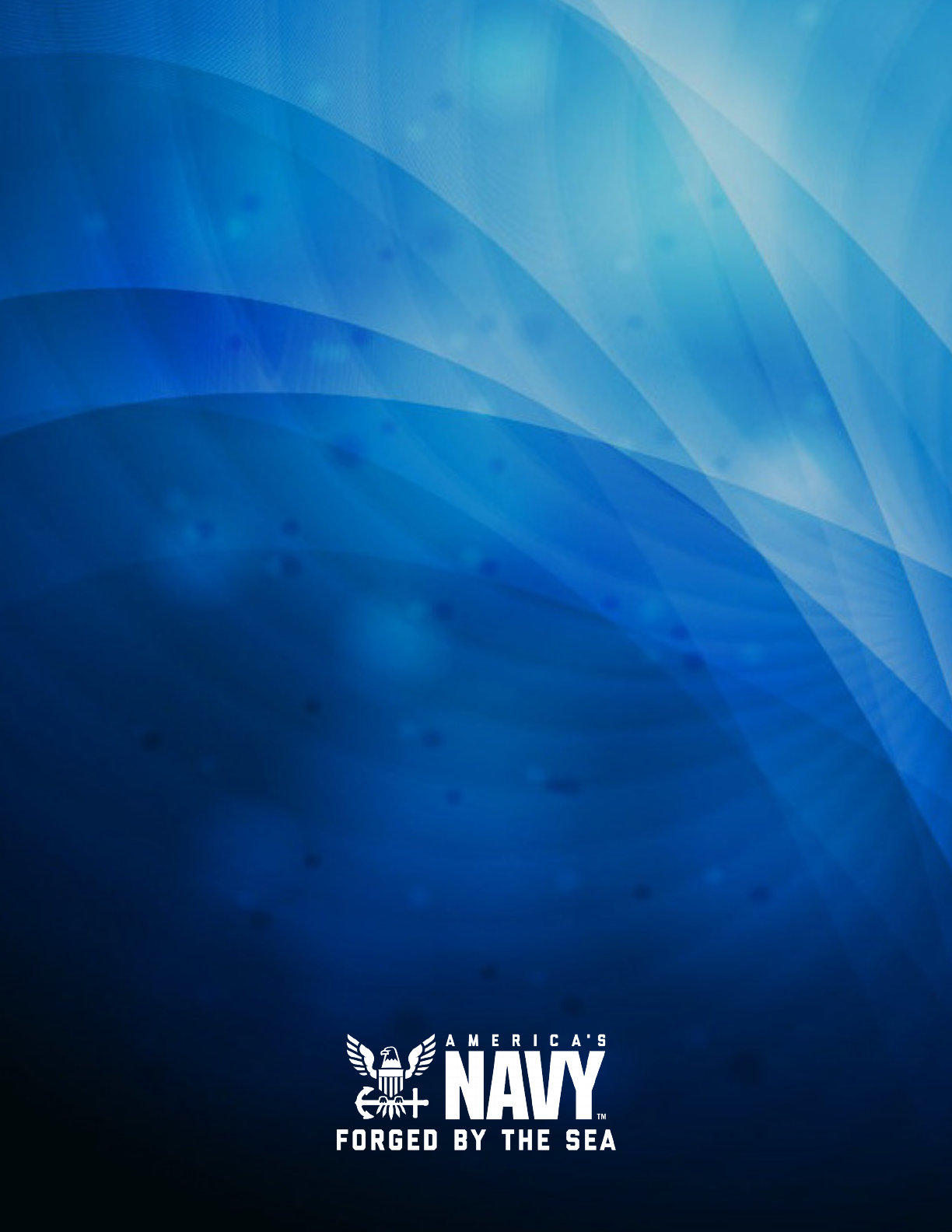
navy
2019
social Media
Handbook

TABLE OF CONTENTS
1 INTRODUCTION
2 LEADERS
2 Overview of Today’s Online Landscape
2 Unofficial (Personal) Use of Social Media
3 Setting the Standard for Online Conduct
3 Reporting Incidents
4 Operations Security (OPSEC )
4 Political Activity
4 Endorsements
4 Impersonators
5 NAVY COMMUNICATORS
5 Overview of Today’s Online Landscape
6 Official Use of Social Media for Navy Commands
6 Policy
7 Deciding if Social Media Is Right for a Command
8 Alternatives
8 Strategy Development and Content Planning
9 Social Listening
10 Social Assessments
14 Crisis Communication: Casualties and Adverse
Incidents
15 Post information as it’s released
16 Correct the record
16 Analyze results
19 Account Security
20 Operations Security (OPSEC)
21 Political Activity and Endorsements
21 Online Advertising
21 Online Conduct
22 Impersonators
22 Bots
i

23 SAILORS
23 Online Conduct
23 Follow the UCMJ
24 Reporting Incidents
24 Political Activity
25 Cybersecurity
25 Cyberbullying
25 Operations Security (OPSEC)
26 Adverse Incidents
27 Private Groups
27 Endorsements
28 FAMILIES
28 Operations Security (OPSEC)
29 Adverse Incidents
29 Cybersecurity
30 Cyberbullying
31 OMBUDSMEN
31 Overview of Today’s Online Landscape
31 Best Practices to Support Command’s
Official Social Media Presence(s)
32 Cybersecurity
32 Operations Security (OPSEC)
33 Cyberbullying
34 Adverse Incidents
34 Private Groups
35 NAVY CIVILIANS
35 Cybersecurity
35 Operations Security (OPSEC)
36 Online Conduct
36 Political Activity
38 APPENDIX
ONLINE CONDUCT
ii

Mention of a commercial product or service in this document does not constitute official endorsement by the U.S. Navy,
the Department of Defense or the federal government.
iii
U.S. Navy Social Media Handbook
for Navy leaders, communicators, Sailors, families, ombudsmen and civilians
March 2019

1
WWW.NAVY.MIL/SOCIALMEDIA >> U.S. NAVY SOCIAL MEDIA HANDBOOK
>> INTRODUCTION
Social media has revolutionized our lives, from the way we communicate and interact with the world to the content we
consume and the news we read. As a result, the way people get information has drastically changed, and the desire to
have real-time conversations with individuals, organizations and government entities has increased. This presents a
tremendous opportunity for everyone, from Sailors and families to Navy leaders and ombudsmen, to more effectively
communicate with one another and to share the Navy story more broadly.
Social media, when used effectively, presents unequaled opportunities for you to share our Navy’s story in an authentic,
transparent and rapid manner — while building richer, more substantive relationships with people you may not have
reached through traditional communication channels.
At the same time, the open, global nature of social media creates challenges, operational and cybersecurity considerations
and concerns regarding online conduct, including cyberbullying and harassment. Careful decisions on the best platforms
to use will ensure you convey the most relevant information as platforms rapidly adapt, age-out or emerge. Each section of
this handbook is tailored to the unique audience it’s serving: Navy leaders, communicators, Sailors, families, ombudsmen
and civilians.
Since social media is constantly evolving, we’ve included only enduring information that will remain relevant. We
encourage you to frequently visit http://www.navy.mil/socialmedia for the latest policy, guidelines, best practices,
standard operating procedures, training and other resources.
If you have questions or want to share feedback, contact the Navy Office of Information at 703-614-9154 or
navysocialmedia@navy.mil.

2
U.S. NAVY SOCIAL MEDIA HANDBOOK >>
>> LEADERS
The Navy has an obligation to provide timely and accurate
information to the public; keep our Sailors, Department of
the Navy civilians and their families informed; and build
relationships with our communities. As a Navy leader, you’re a
crucial part of those communication efforts.
Social media, when used effectively, presents unequaled opportunities for you to share the Navy story in an authentic,
transparent and rapid manner while building richer, more substantive relationships with people you may not have reached
through traditional communication channels.
It’s important to remember that social media is only part of a command’s public affairs program. Navy leaders need to
work with their public affairs team to decide whether social media is appropriate for their command; not every command
needs to use social media. If you decide social media would benefit your command, evaluate each platform to determine
where your efforts will have the most impact; you don’t need to use every platform.
Overview of Today’s Online Landscape
Social media use is nearly universal among younger adults and is quickly growing among people over age 50. People
use it to consume news, make or strengthen connections, and engage in discussions and activism related to personal
interests. There are many different social media platforms, each with distinct use cases. Navy leaders need to work with
their public affairs team to focus their efforts on a social media platform that aligns with the command’s communication
objectives and that its targeted audiences use regularly.
According to a 2018 study by Pew Research Center, the percentage of adults who use at least one social media site
is as follows: 88 percent of 18- to 29-year-olds, 78 percent of 30- to 49-year-olds, 64 percent of 50- to 64-year-olds,
and 37 percent of people 65 and older. In total, nearly two-thirds of adults use social media. Specifically, 68 percent
use Facebook, 35 percent use Instagram and 24 percent use Twitter. Of the 68 percent of adults using Facebook, over
74 percent go onto the platform every day. Fewer users reported logging onto Instagram (58 percent) and Twitter (46
percent) daily.
Unofcial (Personal) Use of Social Media
Unofficial internet posts are posts published on any internet site by a Sailor or a Department of the Navy civilian in an
unofficial, personal capacity that include content about and/or related to the Navy or Sailors.
“Posts” includes but is not limited to personal comments, blogs, photographs, videos and graphics. “Internet sites”
includes but is not limited to social networking platforms, messaging apps, photo and video sharing apps and sites,
blogs, forums and websites with comment sections.
LEADERS

3
WWW.NAVY.MIL/SOCIALMEDIA >> U.S. NAVY SOCIAL MEDIA HANDBOOK
If you’re expressing a personal opinion of any kind, it’s your responsibility to make clear you’re not speaking for the Navy
and that the stance is your own and not representative of the views of the Navy.
Setting the Standard for Online Conduct
As a Navy leader, you must lead by example. You must show your Sailors and Navy civilians that improper or inappropriate
online behavior is not tolerated and must be reported if experienced or witnessed. When it comes to your position as
command leadership, your conduct online should be no different from your conduct offline, and you should hold your
Sailors and civilians to that same standard.
If evidence of a violation of command policy, Uniform Code of Military Justice (UCMJ) or civil law by one of your Sailors
or Navy civilians comes to your attention from social media, then you can act on it just as if it were witnessed in any other
public location. Additionally, pursuant to Navy regulations, you have an affirmative obligation to act on UCMJ offenses
you observe. This adds an ethical wrinkle to friending or following your subordinates; the key is for you to maintain the
same relationship with them online as you do at work and to be clear about that.
Sailors using social media are subject to the UCMJ and Navy regulations at all times, even when off duty. Commenting,
posting or linking to material that violates the UCMJ or Navy regulations may result in administrative or disciplinary
action, to include administrative separation, and may subject Navy civilians to appropriate disciplinary action.
Punitive action may include Articles 88, 89, 91, 92, 120b, 120c, 133 or 134 (General Article provisions for contempt,
disrespect, insubordination, indecent language, communicating a threat, solicitation to commit another offense and child
pornography offenses), as well as other articles, including Navy Regulations Article 1168, nonconsensual distribution or
broadcast of an intimate image.
Reporting Incidents
Anyone who experiences or witnesses incidents of improper online behavior should promptly report it.
Reports can be made to the chain of command via the Command Managed Equal Opportunity manager or Fleet and
Family Support office. Additional avenues for reporting include Equal Employment Opportunity offices, the Inspector
General, Sexual Assault Prevention and Response offices and the Naval Criminal Investigative Service (NCIS).
NCIS encourages anyone with knowledge of criminal activity to report it to his or her local NCIS field office directly or via
web or smartphone app at http://www.ncis.navy.mil/Pages/NCISTips.aspx.

4
U.S. NAVY SOCIAL MEDIA HANDBOOK >>
Operations Security (OPSEC)
One of the best features of social media platforms is the ability to connect people from across the world in spontaneous
and interactive ways. Like most things we do as a Navy, social media can present OPSEC risks and challenges, but
they can be mitigated. Embrace the risks and challenges by reinforcing OPSEC rules, which are universal and should be
maintained online just as they are offline. Make sure your Sailors and Navy civilians as well as their families know that if
they wouldn’t say it, write it or type it, they shouldn’t post it on the internet.
OPSEC violations commonly occur when personnel share information with people they don’t know well or if their social
media accounts have loose privacy settings. As a Navy leader, carefully consider the level of detail used when posting
information anywhere on the internet. Reinforce OPSEC best practices, such as limiting the information your Sailors,
Navy civilians and families post about themselves, including names, addresses, birthdates, birthplaces, local towns,
schools, etc. It’s important to remember small details can be aggregated to reveal significant information that could
pose a threat. Work with your public affairs team to ensure best practices and standard operating procedures, addressed
in this handbook’s section for Navy communicators, are implemented.
Political Activity
Sailors may generally express their personal views about public issues and political candidates on internet sites, including
liking or following accounts of a political party or partisan candidate, campaign, group or cause. If the site explicitly or
indirectly identifies Sailors as on active duty (e.g., a title on LinkedIn or a Facebook profile photo), then the content
needs to clearly and prominently state that the views expressed are the Sailor’s own and not those of the U.S. Navy or
Department of Defense.
Sailors may not engage in any partisan political activity — such as posting direct links to a political party, campaign,
group or cause on social media — which is considered equivalent to distributing literature on behalf of those entities, and
is prohibited. Similarly, as a leader, you cannot suggest that others like, friend or follow a political party, campaign, group
or cause. Additional information is available at https://go.usa.gov/xEEqy.
Endorsements
Navy leaders must not officially endorse or appear to endorse any non-federal entity, event, product, service or enterprise,
including membership drives for organizations and fundraising activities. No Sailor may solicit gifts or prizes for
command events in any capacity — on duty, off duty or in a personal capacity.
Impersonators
Impostor accounts violate most social media platforms’ terms of service. The best offense is a good defense. Regularly
search for impostors and report them to the social media site.
The impersonation of a senior Navy official, such as a flag officer or a commanding officer, should also be reported to
the Navy Office of Information at 703-614-9154 and navysocialmedia@navy.mil.
LEADERS

5
WWW.NAVY.MIL/SOCIALMEDIA >> U.S. NAVY SOCIAL MEDIA HANDBOOK
Social media, when used effectively, presents unequaled
opportunities for you to share our Navy’s story in an authentic,
transparent and rapid manner while building richer, more
substantive relationships with people you may not have
reached through traditional communication channels. Social
media has also led to new, creative ways and places to quickly
and directly tell your command’s story. Don’t be afraid to try
something different.
The Navy has an obligation to provide timely and accurate information to the public; keep Sailors, Department of the
Navy civilians and families informed; and build relationships with our communities.
It’s important to remember that social media is only part of a command’s public affairs program. Navy communicators
need to work with their command leadership to decide whether social media is appropriate for their command; not every
command needs to use social media. If you decide social media would benefit your command, evaluate each platform
to determine where your efforts will have the most impact; you don’t need to use every platform.
Your content — stories, photos, videos (b-roll and productions), infographics (still and video), blogs, etc. — is needed to
tell our Navy’s story. Submit released stories to the Navy.mil content management system and Navy Live blog proposals
to navysocialmedia@navy.mil. Follow current instructions on release of visual information and records management.
Finally, while this handbook will teach you best practices to tell our Navy’s story on social media, remember that there’s
no substitute for personally using social media to understand how to use it professionally.
Overview of Today’s Online Landscape
Social media use is nearly universal among younger adults and is quickly growing among people over age 50. People
use it to consume news, make or strengthen connections, and engage in discussions and activism related to personal
interests. There are many different social media platforms, each with distinct use cases.
As a Navy communicator, you need to focus your efforts on a social media platform that aligns with your command’s
communication objectives and that your targeted audiences use regularly.
According to a 2018 Pew Research Center study, the percentage of adults who use at least one social media site is
as follows: 88 percent of 18- to 29-year-olds, 78 percent of 30- to 49-year-olds, 64 percent of 50- to 64-year-olds, and
37 percent of people 65 and older. In total, nearly two-thirds of adults use social media. Specifically, 68 percent use
Facebook, 35 percent use Instagram and 24 percent use Twitter. Of the 68 percent of adults using Facebook, over 74
>> NAVY COMMUNICATORS

6
U.S. NAVY SOCIAL MEDIA HANDBOOK >>
percent go onto the platform every day. Fewer users reported logging onto Instagram (58 percent) and Twitter (46
percent) daily.
Social media provides the ability to share news with your audience, with limitations. About two-thirds of American adults
(68 percent) say they at least occasionally get news on social media,. However, a majority (57 percent) say they expect
the news they see on social media to be largely inaccurate.
We know young Americans are very active on social media, but they’re less likely to show they’re engaged in content.
Though people age 18-29 are almost 20 percent more likely to use social media than people age 50-64, the older group is
4 percent more likely to share or repost a news story on social media and 10 percent more likely to comment on a news
story. These metrics should influence your command’s content strategies. If you want your messaging to resonate with
a younger audience, work on developing content that will engage younger users.
Teenagers use social media differently from other age groups. They’re less likely to use Facebook than older cohorts.
Roughly one-third of teens ages 13 to 17 say they visit Snapchat (35 percent) or YouTube (32 percent) most often, while
15 percent say the same of Instagram. Roughly half of teens (51 percent) say they use Facebook, and only 10 percent
say it’s their most-used online platform.
Social media use differs across different fleet areas of operation. In Asia, messaging apps, such as WeChat, LINE and
Facebook Messenger are more popular than traditional social media platforms. Similarly, in the Middle East, WhatsApp
is the most used social app, although Facebook and Instagram are also popular. Although Facebook is by far the most
popular social media platform across most of Europe, the Russian site VKontakte dominates in Russia, Belarus and
Kazakhstan.
Don’t feel that you must use multiple platforms. It’s far better to have one successful social media site than multiple
sites that aren’t used effectively.
Official Use of Social Media for Navy Commands
Navy social media sites are official representations of the Department of the Navy and must demonstrate professionalism
at all times. While third-party sites such as Facebook and Twitter are not owned by the DoN, there are guidelines for the
management of Navy social media accounts.
Policy
Department of Defense Instruction (DoDI) 8550.01, released Sept. 11, 2012, discusses the use of Internet-based
capabilities (IbCs), such as social media, and provides guidelines for their use. The instruction acknowledges IbCs are
integral to operations across the DoD. It also requires the NIPRNet be configured to provide access to IbCs across all DoD
components while balancing benefits and vulnerabilities. By definition, IbCs don’t include command or activity websites.
DoDI 8550.01 requires that all official social media presences be registered. Official Navy social media sites need to be
registered at http://www.navy.mil/socialmedia. SECNAVINST 5720.44C Change 1, Department of the Navy Public Affairs
Policy & Regulations, provides policy for the official and unofficial (personal) use of social media and for the content and
NAVY COMMUNICATORS

7
WWW.NAVY.MIL/SOCIALMEDIA >> U.S. NAVY SOCIAL MEDIA HANDBOOK
administration of official Navy presences on social media, to include:
ADMINISTRATORS: Commands and activities shall designate administrators for official use of IbCs in writing.
The administrator is responsible for ensuring postings to the IbCs comply with content policy. Commands
permitting postings by others must ensure the site contains an approved user agreement delineating the types
of information unacceptable for posting to the site and must remove such unacceptable content. At a minimum,
the DoN’s current social media user agreement is required, available at http://www.navy.mil/socialmedia.
LOCAL PROCEDURES: Commands and activities must develop written local procedures for the approval and
release of all information posted on command and activity official use of IbCs.
SECURITY: Commands will actively monitor and evaluate official use of IbCs for compliance with security
requirements and for fraudulent or unacceptable use.
PRIMARY WEB PRESENCE: A command or activity IbC presence, including those on blog platforms, may not
serve as the DoN entity’s primary web presence and must link to the primary web presence, the command or
activity’s official website.
PROHIBITED CONTENT: Commands and activities shall not publish and shall prohibit content such as:
Personal attacks; vulgar, hateful, violent or racist language; slurs, stereotyping, hate speech, and other forms
of discrimination based on any race, color, religion, national origin, disability or sexual orientation.
Information that may engender threats to the security of Navy and Marine Corps operations or assets or to
the safety of DoN personnel and their families.
CORRECTIONS TO PREVIOUS POSTS: If correcting a previous post by another contributor on an IbC presence,
such posting is done in a respectful, clear and concise manner. Personal attacks are prohibited.
Deciding if Social Media Is Right for a Command
Social media is not a silver bullet for all your command’s communication needs. Not every command needs a social
media presence. It’s far better not to start a social media site than to use it ineffectively and abandon the site.
Before launching a social media presence, consider what you want to accomplish. What are your communication
objectives and how do they move your command closer to achieving its mission? Is the level of transparency required
in social media appropriate for your command and its mission? You also should consider your command’s priority
audiences and use the right social media platform to reach them. Do you want to communicate with your Sailors, Navy
civilians, command leadership, family members, the local community, a broader DoD audience, the American public or
another group altogether? Do you have the content and personnel — both now and long term — to routinely engage with
those audiences?
Additionally, if your command already has a social media presence, you should routinely ask yourself the above questions
to ensure it remains an effective communications tool. If it isn’t, take the opportunity to address the underlying issues
using the best practices in this handbook.

8
U.S. NAVY SOCIAL MEDIA HANDBOOK >>
Alternatives
If your command wants to share information or content privately, social media is not your solution. Social media
is never the right venue for sharing sensitive information.
If you have sensitive information you want to limit to a specific group, consider one of the Navy’s private portals
that require a Common Access Card.
If the information or content is to be shared only with family members, consider using a dial-in family line or
conveying it through the command ombudsman, emails or family readiness group meetings.
If the information or content is to be shared with the local community, but the command is not subordinate to
Navy Installations Command, contact the base public affairs officer and/or the Navy region PAO.
If you have information or content that does not regularly change, consider the command’s public website.
Don’t create social media presences for individual missions, exercises and events. Instead, coordinate with
relevant commands and provide them content that is optimized — both written and visually.
Strategy Development and Content Planning
Social media is not a substitute for a public affairs program. As you decide how social media can support it, consider
your audience(s), goal, objectives and assessment method.
As public affairs plans are developed, discuss how to gather and produce content that is optimized — both written and
visually — for specific platforms based on your command’s social media strategy. A single event, such as a change-
of-command ceremony, can result in multiple products, such as a Navy.mil story, live tweets, a blog from the outgoing
and/or incoming commanding officer and a social media graphic with a quote — all from prepared remarks that can be
requested before the ceremony.
Once released, all Navy content is in the public domain and may not include any copyrighted material such as music,
photos, videos or graphics without the appropriate licensing.
In addition to deciding what you’ll create, discuss when and where you’ll share it. Not all your content needs to be shared
at once or on all your sites. For example, content shared on the Navy’s Twitter account is frequently not shared on
Facebook and vice versa. The Twitter account is a blend of news about the Navy and relevant trending content related
to the Navy that attracts new followers. Additionally, the posting frequency is different. Since Twitter is about what’s
happening in the moment, content is tweeted more often than posted on Facebook.
When content about a single topic is shared on Facebook and Twitter, it’s optimized for that platform. The tweet is
much shorter (due to Twitter’s 280-character limit) and includes relevant hashtags and mentions of other Twitter users.
Visually, the supporting imagery is edited by size and duration for each platform.
Once you’ve developed your content plan, update your content calendar. It can be tempting to connect, for example, a
Facebook account to a Twitter account so they automatically post to each other. Even though it will save you time, it’s not
an effective approach. Instead, it indicates you likely don’t have the personnel and content to sustain more than one site.
NAVY COMMUNICATORS
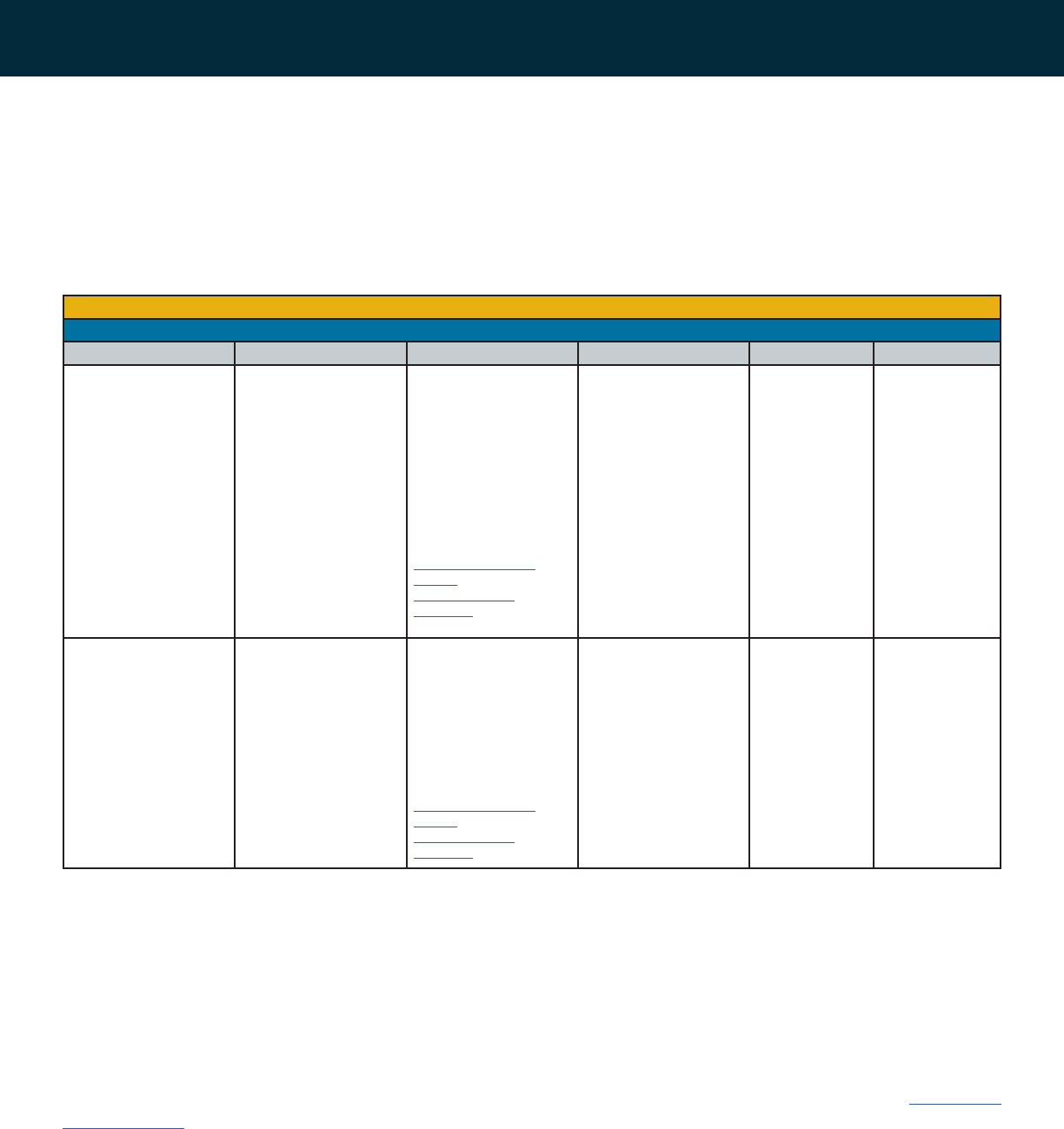
9
WWW.NAVY.MIL/SOCIALMEDIA >> U.S. NAVY SOCIAL MEDIA HANDBOOK
Commands are responsible for official content posted on their social media. Like a press release or content posted
to a Navy website, information posted to an official social media presence must be approved by a release authority.
Contractors may help manage a social media presence, but they can’t serve as a spokesperson for the Navy. Therefore,
a Navy release authority must review and approve all content before a contractor posts it.
This is an example portion of CHINFO’s content calendar:
Social Listening
An important part of a social media strategy is keeping track of what’s being said about your command and understanding
the significance of specific social conversations. Social listening is different from social monitoring. Listening involves
both tracking mentions of a specific topic and extracting insights relevant to your strategy; listening can reveal sentiment
and trends.
While the most powerful social listening tools cost money, there are no-cost options. Search for free tools that work
across multiple platforms and allow users to monitor specific search terms in real time. TweetDeck (http://www.
tweetdeck.com) is a free Twitter tool that allows users to schedule tweets, view multiple timelines in one interface and
track specific hashtags in one location. TweetDeck allows you to set up columns in the main dashboard for certain
search terms or mentions of specific accounts.
Friday, February 15, 2019
Facebook
Time Type of content Text Imagery Line of effort Status
0935 Link This weekend, our
#USNavy’s newest
Independence-variant littoral
combat ship, the future
USS Tulsa (LCS 16), will
be commissioned in San
Francisco, expanding our
capacity. Be sure to watch
the ceremony live Saturday
at 1 p.m. (EST) / 10 a.m.
(PST) on our Facebook
page.
https://www.navy.mil/
submit/
display.asp?story_
id=108602
Link preview from story Equip Scheduled
(Approved by CM)
1217 Link During Exercise Citadel
Shield-Solid Curtain,
continental #USNavy
installations used realistic
training scenarios to
ensure their security forces
maintain a high level of
readiness. In Texas, those
scenarios turned from
training to reality.
https://www.navy.mil/
submit/
display.asp?story_
id=108629
Link preview from story Train Pending approval

10
U.S. NAVY SOCIAL MEDIA HANDBOOK >>
Social Assessments
To ensure your social media efforts are achieving your aims, you should conduct periodic assessments. Each social
media site provides in-platform analytics. Tracking analytics weekly or monthly will reveal what type of content performs
best. In addition to the keeping track of the size of your audience, it’s important to see what content has the greatest
reach and receives the most engagement from your followers.
Assessments are also useful to evaluate one-off events and demonstrate to leadership the importance of social media
for communicating Navy messaging. See the following historical example assessing the impact of content related to
April 2018 strikes against chemical weapons capabilities in Syria. All the information in the report, which was captured
within the first 72 hours of content being posted, comes from analytics available in-platform on Facebook, Twitter and
YouTube.
SOCIAL MEDIA ASSESSMENT | SYRIA STRIKES
APRIL 17, 2018
BLUF: On April 13, 2018, combined U.S., French and British forces launched precision strikes against chemical
weapons capabilities in Syria to deter Syrian leader Bashar al-Assad from using banned chemical weapons. In the
72 hours that followed, CHINFO shared social media content related to the strikes on the Navy’s Facebook, Twitter
and YouTube accounts.
This content reached a large audience of Navy social media followers and users associated with those followers:
content related to the strikes was viewed over 800,000 times on Facebook, over 260,000 times on Twitter and over
200,000 times on YouTube.
On Facebook and Twitter, comments and replies generally reflected positive sentiment and expressed appreciation,
although users opposed to the strikes also left comments. The majority of comments left on YouTube videos were
in Russian and contained misinformation.
Summary: Social media posts related to the strikes reached a large audience and received generally positive
feedback. In total, related social media content was viewed over 1.2 million times and generated over 12,000
engagements. On YouTube, Russian actors appear to be engaged in a misinformation campaign.
Recommendation: Counter misinformation spread by Russian actors on YouTube. Consult with YouTube to
report the suspected misinformation campaign. Respond to English-language comments containing blatant
misinformation, and possibly remove Russian-language comments.
Total as of 12 p.m. April 17, 2018:
Facebook Impressions Earned via Related Content: 810,643
Facebook Accounts Reached via Related Content: 565,813
Facebook Engagements on Related Content: 8,629
Twitter Impressions Earned via Related Content: 260,550
Twitter Engagements on Related Content: 34,188
Twitter Retweets of Related Content: 538
YouTube Views on Related Content: 205,876
YouTube Comments on Related Content: 258
NAVY COMMUNICATORS
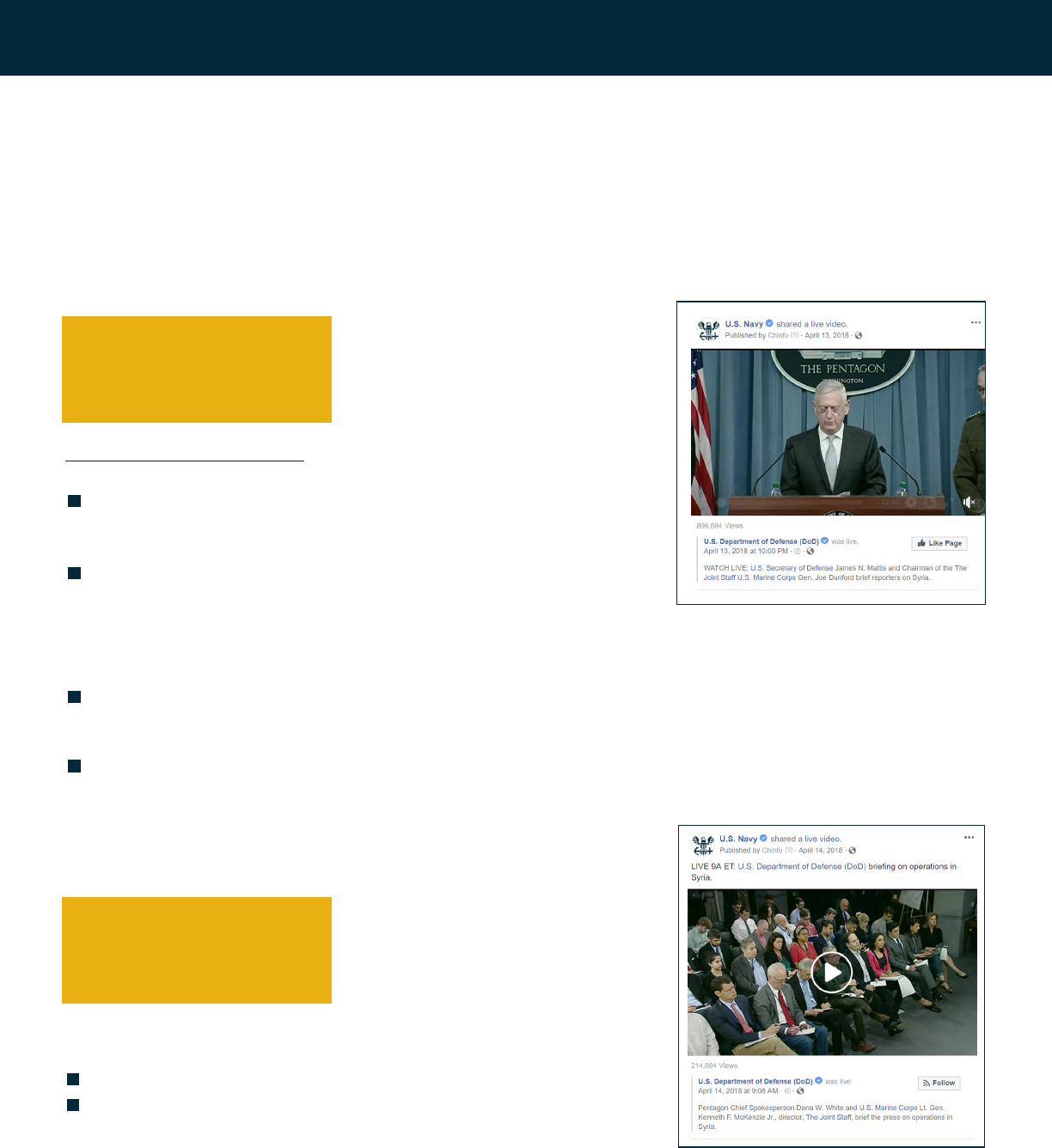
11
WWW.NAVY.MIL/SOCIALMEDIA >> U.S. NAVY SOCIAL MEDIA HANDBOOK
Facebook
Facebook content related to the strikes reached 565,813 users, received 810,643 impressions and generated 8,629
engagements. Comments were generally appreciative, although users opposed to the strikes also left comments.
1. SHARE: WATCH LIVE: SECDEF James N. Mattis and Chairman of the Joint Staff Gen. Joe Dunford brief reporters
on Syria
Impressions: 371,573
People reached: 251,148
Engagements: 4,896
Video views: 73,841
Theme of comments: Support
Example comments:
Anyone not ok with this attack and Trump’s decision. Look at your
kid or grandchild and imagine them in a gas attack. Sorry for being
so blunt but think about it. God bless our troops involved.
Be safe and show them WE are behind our President and our troops!!
Pray for them all!!
Theme of comments: Opposition
Example comments:
The United States has no place in this, should stay out of it all together not enough evidence to support any claims
the Syrian government did any such thing but then again since when did the US Government need proof to attack
another country - Love thy country hate thy government...
Trump wants to be known as a war president. A twitter war, a conventional war, a nuclear war, he doesn’t care,
as long as it’s a war. We have no business messing with Syria, or any other country for that matter.
2. SHARE: LIVE 9A ET: DoD briefing on operations in Syria
Impressions: 186,780
People reached: 129,032
Engagements: 1,260
Video views: 26,456
Theme of comments: Appreciation
Example comments:
Proud of my Navy and our allies
God bless our National Defense and the USA
YouTube Views on Related Content: 205,876
YouTube Comments on Related Content: 258

12
U.S. NAVY SOCIAL MEDIA HANDBOOK >>
3. SPECIAL REPORT: INTERNATIONAL RESPONSE TO ASSAD CHEMICAL WEAPONS
Impressions: 252,290
People reached: 185,633
Engagements: 2,473
Theme of comments: Support
Example comments:
Well done Navy, and special thanks to our brothers in the
Submarine Service, who by necessity often patrol in thankless
secrecy. I believe I saw a Los Angeles class submarine was
instrumental in the strike, according to the public brief given less
than an hour ago. I’m afraid I didn’t catch the name of the boat
however. My thoughts and prayers are with our military, especially
our Navy. Thank you for your service past, present and future.
Theme of comments: Opposition
Example comments:
Chemical weapons use in Syria is not new. Why retaliate now? Because Trump needs a big distraction. I don’t
approve of Syrian leadership, however the time to have done this was years ago. This is just political grandstanding.
What happened to congressional approval? In 2013 he was all over Obama for the mere thought of getting
involved in Syria. Oh wait, that was when we had a real president not a dictator. Here is one of his many tweets
on the subject - “What will we get for bombing Syria besides more debt and a possible long term conflict? Obama
needs Congressional approval.
Twitter
Twitter content related to the strikes received 260,550 impressions and generated 3,418 engagements. The Navy’s
tweets on the strikes were retweeted 538 times. Replies were generally positive and expressed appreciation.
1. POTUS announces #SyriaStrikes
Impressions: 157,497
Total engagements: 2,194
Retweets: 320
Theme of replies: Appreciation
Example replies:
Stay safe.
We are praying for your safety and security
NAVY COMMUNICATORS
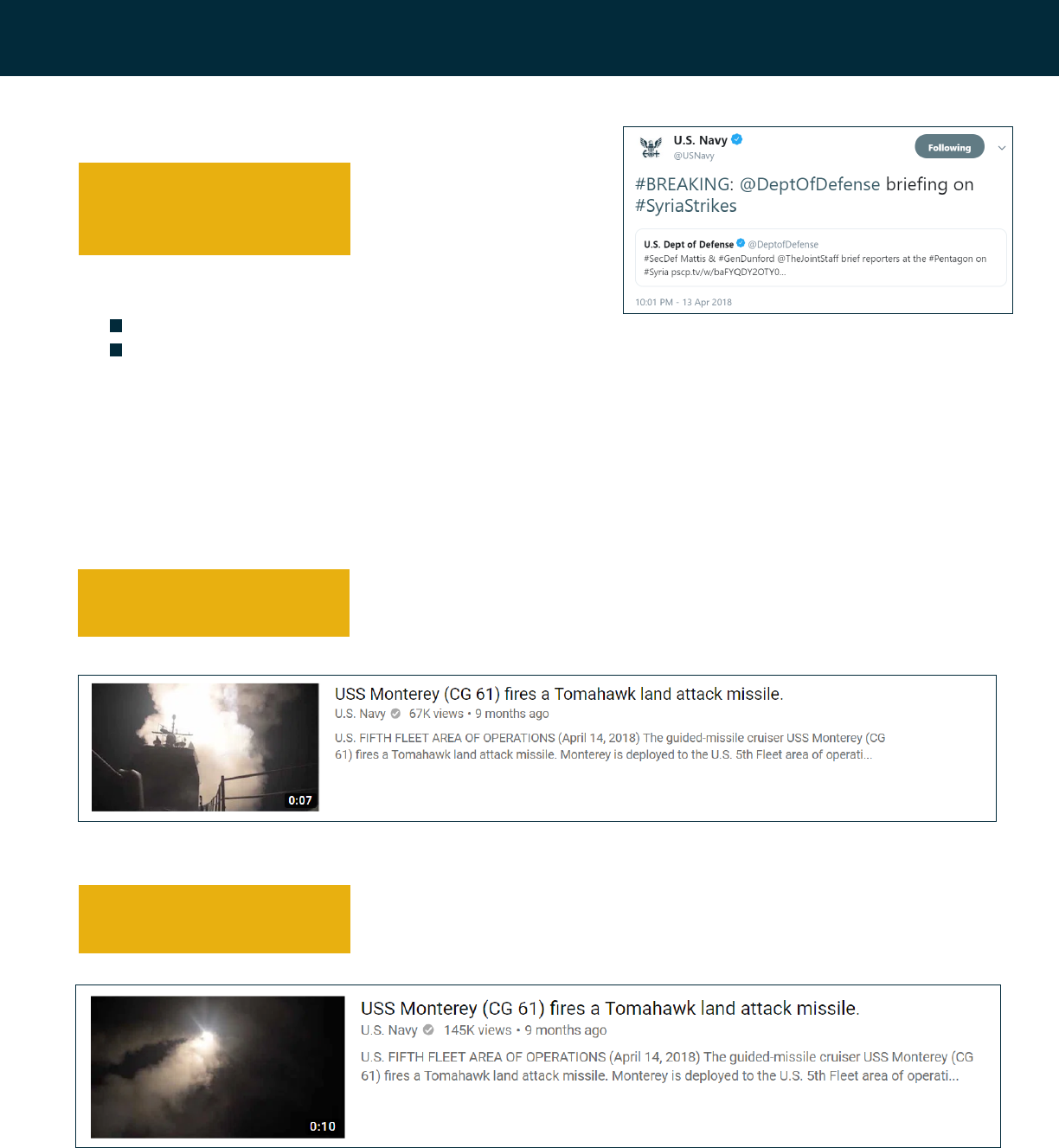
13
WWW.NAVY.MIL/SOCIALMEDIA >> U.S. NAVY SOCIAL MEDIA HANDBOOK
2. #BREAKING: @DeptOfDefense briefing on #SyriaStrikes
Impressions: 103,053
Total engagements: 1,224
Retweets: 218
Theme of replies: Appreciation
Example replies:
This was an extraordinary briefing. Excellent
Praying for all our brave service men and women. Thank you for your sacrifice.
YouTube
YouTube videos of the strikes were viewed 205,876 times and received 258 comments. The majority of comments left
on the three videos were in Russian and contained misinformation.
1. USS Monterey (CG 61) fires a Tomahawk land attack missile.
Video views: 61,402
Comments: 65
2. USS Monterey (CG 61) fires a Tomahawk land attack missile.
Video views: 140,561
Comments: 161
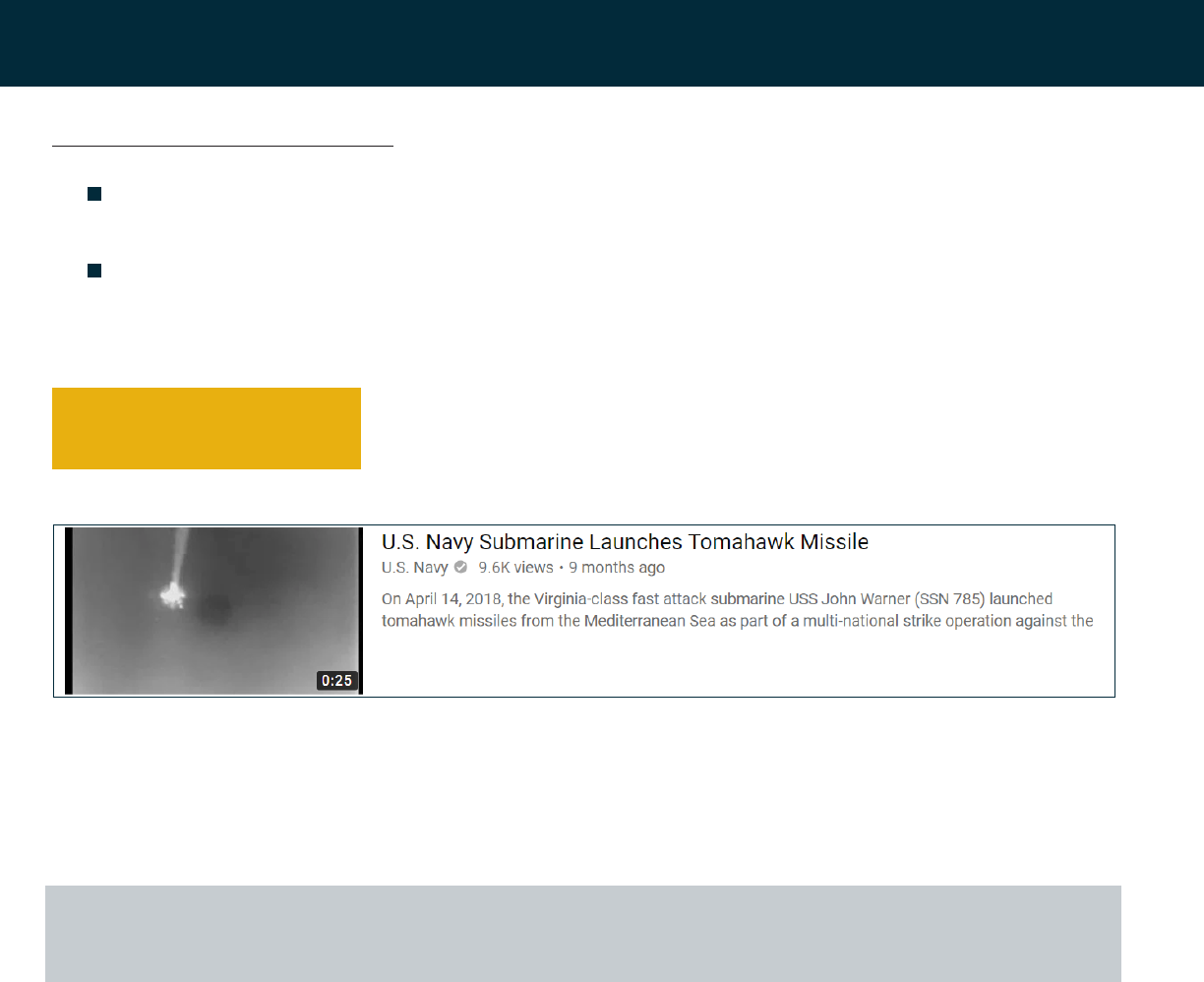
14
U.S. NAVY SOCIAL MEDIA HANDBOOK >>
Theme of comments: Misinformation
Example replies:
Where are the “smart” missiles. 103 rockets were produced. 71 missiles shot down. 17 missiles fell or exploded
in the desert. Only 15 rockets exploded near the target. These are very, very “stupid” missiles. this is the army
number one with the last place. America this attack cost $ 200 million, damage from missiles 0. it’s a shame.
Shity rockets. Almost all the missiles were shot down by the old Soviet air defense system xD
3. U.S. Navy Submarine Launches Tomahawk Missile
Video views: 3,913
Comments: 32
Crisis Communication: Casualties and Adverse Incidents
Social media is a major part of most people’s lives during good times and bad times. Using social media to communicate
with stakeholders during a crisis has proven effective due to its speed, reach and direct access. Social media distributes
official information and facilitates dialogue among the affected and interested parties.
If you can release information to the media, you can release the same information via your social media channels. As
you develop the crisis-communication portion of your public affairs guidance and plans, include possible social media
posts and tweets with your traditional holding statements.
Casualties
When personnel are killed, wounded or missing in action, it’s hard to control the flow of information distributed through
social media platforms. While it’s difficult to prepare for these situations, it’s important to know that social media can
play a role (good or bad).
The media may look at command, Sailor, DoN civilian and family members’ social media to get more information. It’s
important that privacy settings be regularly reviewed to be as restrictive as practical. It’s too late during a crisis.
It’s vitally important that all Sailors, DoN civilians, family members and friends know that the identity of a casualty
should not be discussed on social media until it’s been released. In accordance with DoDI 1300.18, DoD Personnel
Casualty Matters, Policies and Procedures, no casualty information on deceased military or DoD civilian personnel may
NAVY COMMUNICATORS
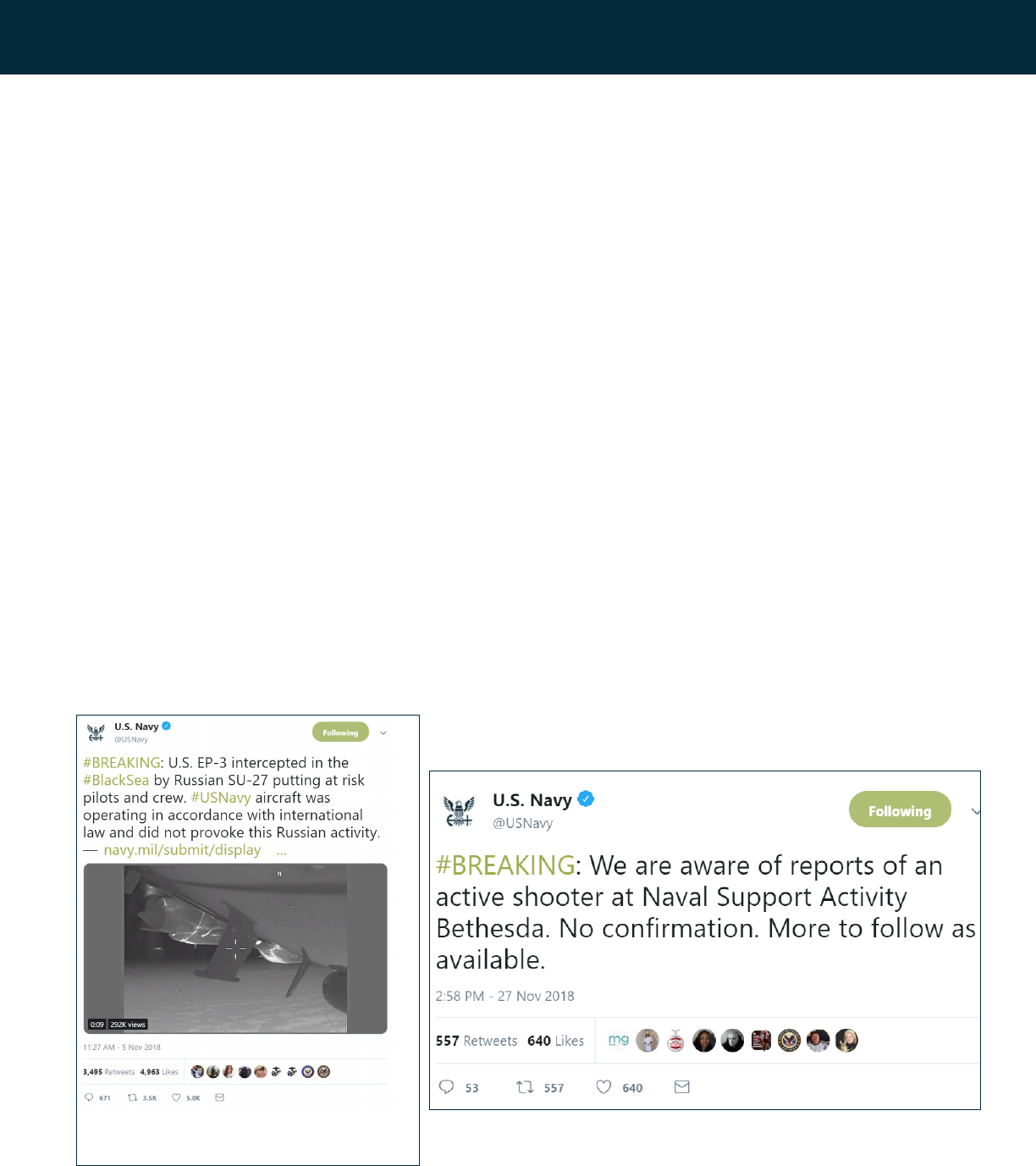
15
WWW.NAVY.MIL/SOCIALMEDIA >> U.S. NAVY SOCIAL MEDIA HANDBOOK
be released to the media or the general public until 24 hours after notifying the next of kin regarding the casualty status
of the member. In the event of a multiple-loss incident, the start time for the 24-hour period commences upon the
notification of the last family member.
Adverse Incidents
The time to start using social media isn’t during a crisis. To build credibility, you need to establish a social media presence
before a crisis. A large social media following doesn’t happen overnight, so relax and execute your social media strategy.
The better you’re at providing good information and engaging your audience, the faster your following will grow.
The best course of action during a crisis is to leverage existing social media presences. If you have a regularly updated
channel of communication before a crisis, then your audiences will know where to find information online. Don’t make
your audience search for information. For example, if your command is preparing for severe weather, tell your audience
where they should go for the latest information.
Post information as it’s released
Social media moves information quicker than ever, so when a crisis hits, don’t wait for a complete formal press release.
When you have information that’s released and confirmed, post it. You can always post additional information as it’s
released. If you expect you’ll provide updates, say so. Not posting timely updates during a crisis may damage the
command’s credibility.
While the below examples are from Twitter, the same principles apply to other social media platforms.
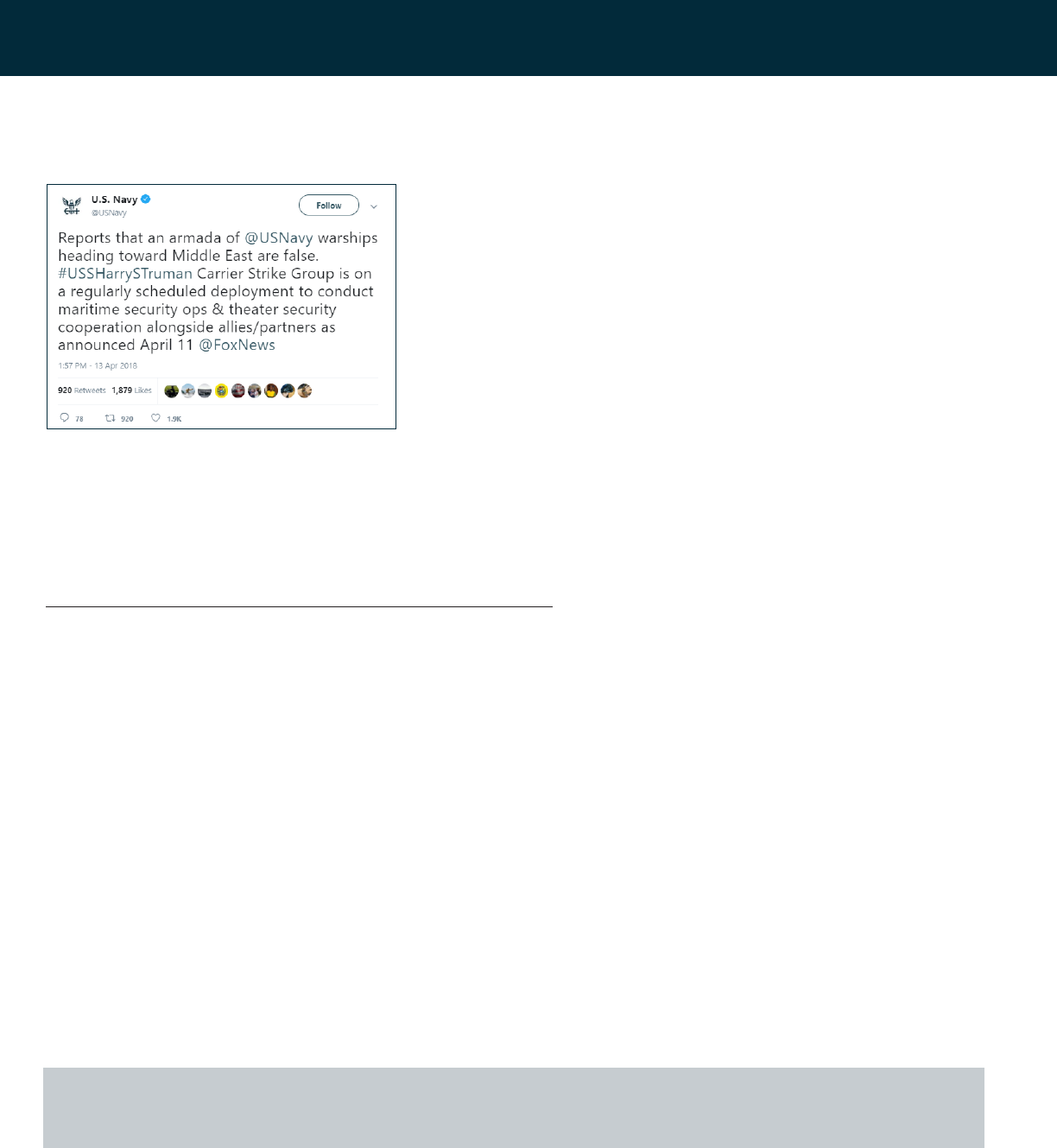
16
U.S. NAVY SOCIAL MEDIA HANDBOOK >>
Correct the record
This example is a reminder to be prepared to respond to misinformation
and rumors before they become widespread.
Following media reports that the Navy was sending an “armada” of 12
ships to the Middle East, the Navy tweeted a correction.
If the Navy had not replied with a coordinated response, this inaccurate
news story would have gained traction. It would’ve been much more
difficult to correct additional media reports and the resulting
social media conversation.
Analyze results
Once the crisis is over, analyze what happened. Evaluate metrics and track user feedback. It’s important to evaluate how
a social media presence performs during a crisis so adjustments can be made for the future.
Case study: USS Fitzgerald and USS John S. McCain collisions
The Navy’s use of Twitter following the June 2017 USS Fitzgerald and MV ACX Crystal collision and after the August
2017 USS John S. McCain and Alnic MC collision provide examples of best practices for keeping the public up-to-date
during a fast-moving news situation.
Build relationships. Don’t wait for something big to happen to get familiar with the public affairs officer in charge
of media queries, build relationships on Twitter with your local media, know who your social media influencers are and
communicate with them often. If you wait until you need someone to get to know them, you’ve waited too long.
Have a well-trained team. Be comfortable using Twitter before a crisis. Even if you’re the Twitter guru on your
team, make sure the rest of your colleagues understand how to use the platform. For the Fitzgerald and McCain collisions,
CHINFO had three people dedicated to various Twitter-related tasks. So set up a training session, have your colleague sit
beside you when you draft tweets and recommend some reading. Make sure you have people in your office, other than
yourself, who you trust to tweet on behalf of your command. You never know when you’ll need the help.
Be able to react quickly. The first step in a crisis situation is confirmation. You may not know all the details, and
that’s okay, but the people involved and the media want information. The days of waiting for that perfectly polished press
release are over. News is happening, and it’s happening now.
Instead of waiting to release a statement until you have the full story, ask yourself, “What do I know now?” This is where
being a trusted adviser is critical. Talk to leadership and emphasize the need to get ahead of the press release with
confirmed and releasable facts, but remember speed does not replace the need for accuracy.
NAVY COMMUNICATORS
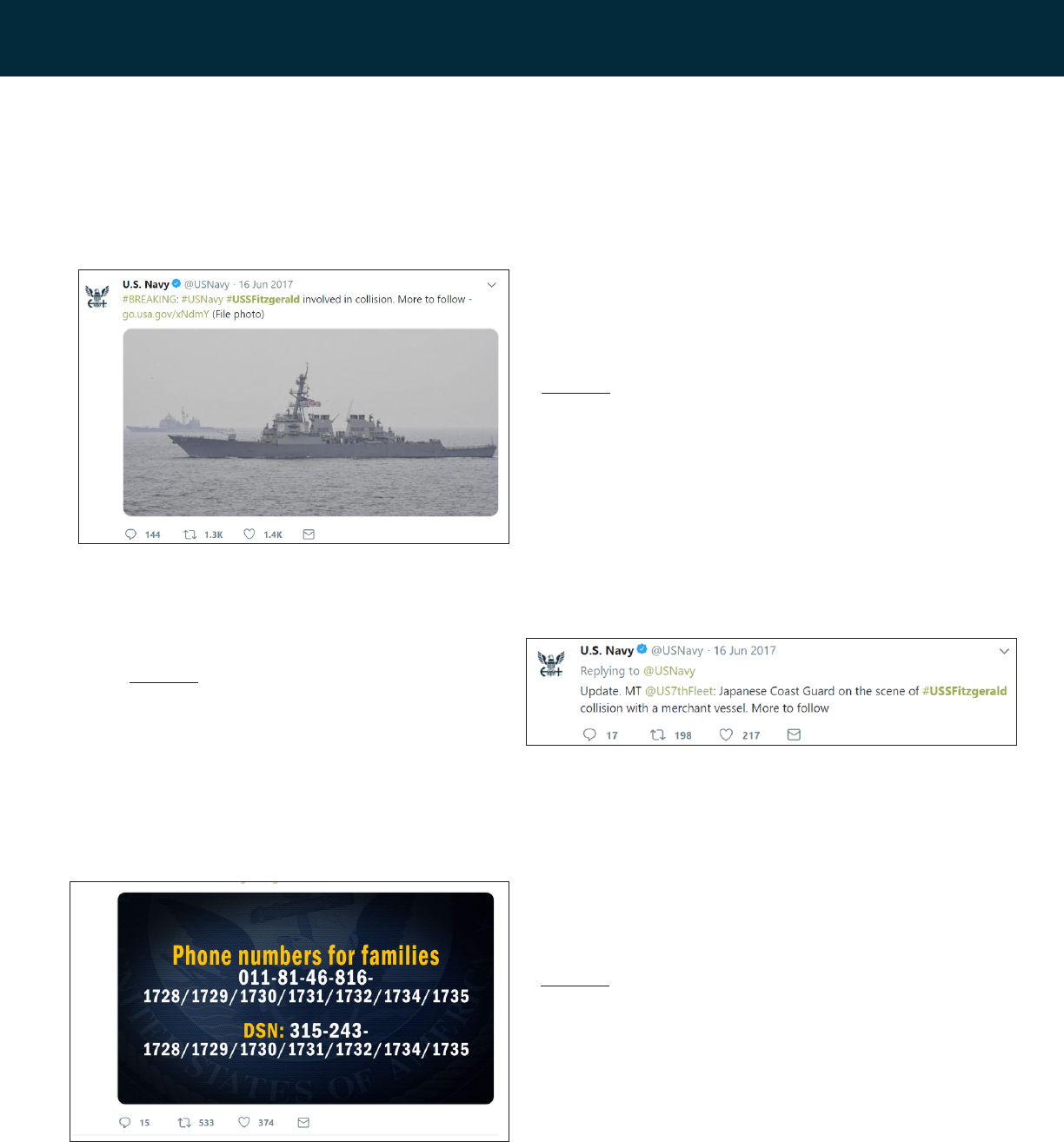
17
WWW.NAVY.MIL/SOCIALMEDIA >> U.S. NAVY SOCIAL MEDIA HANDBOOK
For both events, we knew there was a collision, we knew the location and we knew about efforts to recover missing
Sailors. The ability to tweet that information once released — even before the full press release was complete — helped
to frame the story and controlled misinformation. Additionally, since we knew there would be frequent updates, we told
the media to monitor the Navy’s Twitter account for the latest information.
Tweet 1: Initial breaking news with link to Navy.mil
Tweet 2: Updates were shared as they became
available
Tweet 3: Resources for affected families were shared
as they became available
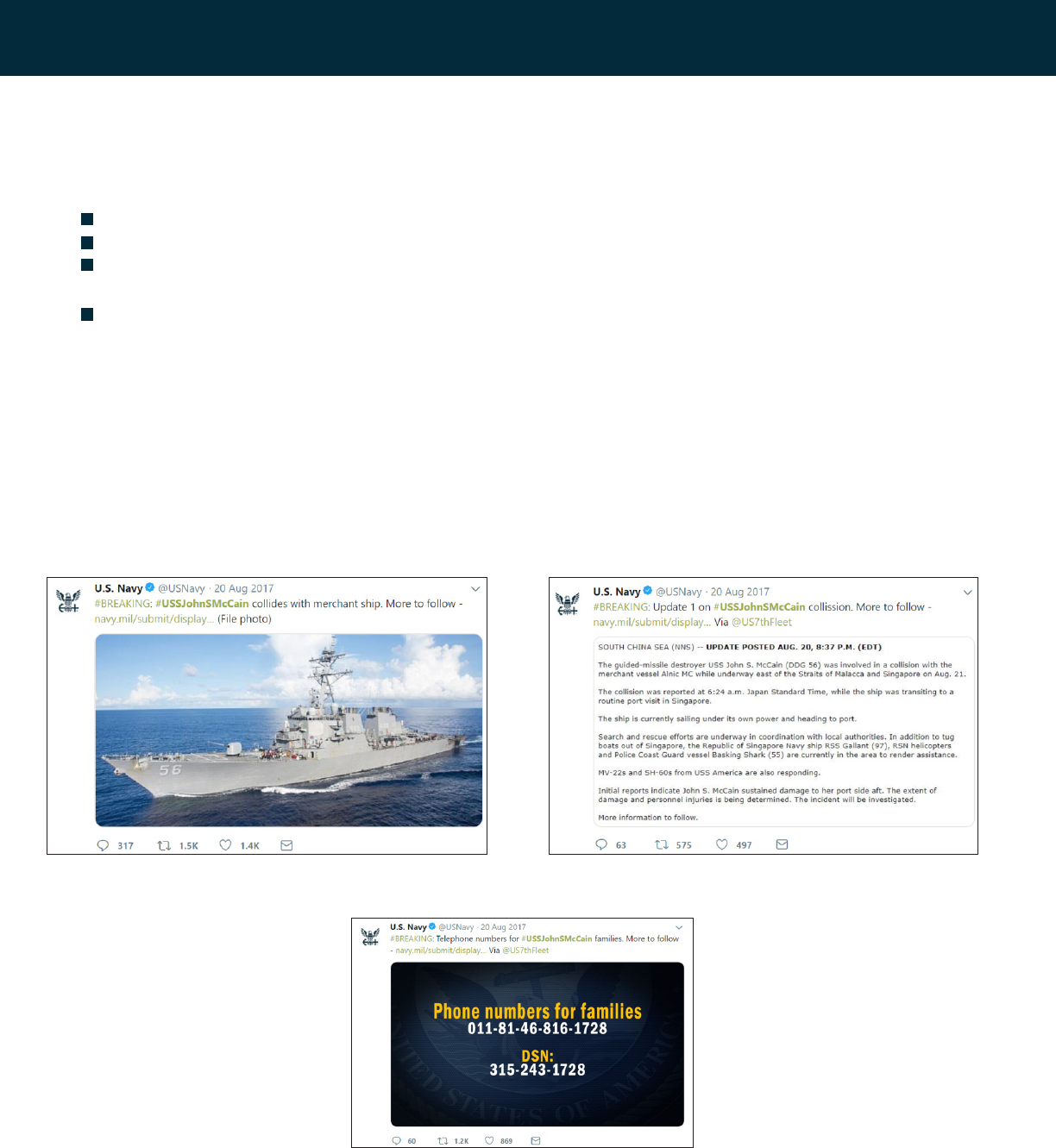
18
U.S. NAVY SOCIAL MEDIA HANDBOOK >>
Sending tweets is only half your job. Twitter is complex. A lot is happening all the time, and it’s hard to keep up without
diligently monitoring. CHINFO has several established monitoring streams we check throughout the day, but in an
instance like the Fitzgerald and McCain collisions, they weren’t enough. Set up the following streams that you and your
team should monitor daily:
Mentions of your account’s handle (e.g., @USNavy)
Your retweets
Keywords associated with your command. We know not everyone uses our handle (@USNavy) so we also search
for mentions of Navy, USNavy, #USNavy and U.S. Navy
Campaign or incident-specific keyword searches (e.g., “Navy + collision”)
In a crisis, we adapt and add streams based on how people are talking about the incident. Following both collisions, we
used the hashtags #USSFitzgerald and #USSJohnSMcCain to make it easier to group and track conversations about the
incident, but we also monitored mentions of “Navy + collision.”
When something of this scale happens, it’s best to present one united and informed Navy voice to the public. There will be
a lot of questions. People will dig for information. It’s your job to identify the right voice. Identifying and directing people
to the appropriate spokesperson and online source of information will go a long way to help minimize misinformation.
Step 1: Confirmation of breaking news with link to Navy.mil Step 2: Updates when available
Step 3: Supporting resources to carry the conversation forward
NAVY COMMUNICATORS

19
WWW.NAVY.MIL/SOCIALMEDIA >> U.S. NAVY SOCIAL MEDIA HANDBOOK
Following each collision, @USNavy was the “digital spokesperson” for the Navy, providing updates for both the media and
affected families. Timely and accurate updates establish trust in your account as an important source of information.
Crisis situations often follow a bell curve. There’s a point where conversations decrease and stabilize. Once that occurs,
there isn’t a need to post minute-by-minute updates, but you should still be an active participant in the conversations.
For weeks following each collision, there were spikes in conversation when new information was released. And there
will still be people wanting more information. Continue to monitor and be ready to direct people to the correct point of
contact for more information on your topic.
Account Security
Official Navy Facebook pages must be attached to individuals’ Facebook profiles. Don’t share a generic Facebook profile;
this frequently leads to commands losing access to their pages. Instead, your designated page administrator will use
his or her personal Facebook account to manually authorize specific Facebook users to manage the official page. The
administrator should grant access to multiple users to minimize the chance of permanently losing access to the page.
Once the individual is granted access, updates to the command’s Facebook page will be posted to the command’s page
and not the individual’s.
What’s often blamed on social media hacking is rooted in poor account management: easy-to-guess passwords;
passwords that aren’t changed periodically or after personnel depart; or lazy device security, such as unlocked computers
or mobile devices. Fortunately, these risks can be mitigated.
Even if your password is strong, adversaries may still be able to gain access to your accounts through weak privacy
options or third-party access. Carefully look at your security options on each platform to minimize the possibility of
unwanted entry. Providing a third-party app or plug-in access to one of your social media accounts can seem like a good
idea, but if one of those third-party apps is compromised, your account likely will be as well. Many of those apps and
plugins are written by unknown third parties who may use them to access your data and friends. Be conservative about
granting third-party apps access, and diligently review who has access to your accounts and eliminate apps you aren’t
familiar with or no longer use.
If you suspect your command’s account has been hijacked or vandalized, follow these steps:
1. Timing is critical in these initial minutes. First, complete a support request through the social media site.
Simultaneously, notify your higher command’s PAO and your command’s security officer. Then, immediately contact
CHINFO. During regular working hours, call Navy Media Content Operations at 703-614-9154. Outside regular working
hours, contact the CHINFO duty officer at 703-850-1047 and request assistance from the digital media team.
2. Change all other social media passwords. Even if you think the security breach is limited to the one account, it’s
prudent to change the passwords of all other social media accounts. If you’ve lost control of other accounts, contact
those platforms immediately as well as CHINFO. You should also change the passwords on your personal accounts.
3. If you don’t have access to your account yet, use other accounts to alert your online community of the breach.

20
U.S. NAVY SOCIAL MEDIA HANDBOOK >>
The right words and speed matter. Regardless of whether you have access, carefully decide what you’ll say. The
samerules for crisis communication offline apply online. Remember: A traditional 24-hour news cycle offline can
occur in just a few minutes online.
4. Once you’ve regained control of your account, change your password and screen shot the unauthorized content
before deleting it.
Operations Security (OPSEC)
We all know that “Loose Lips Sink Ships,” and social media amplifies OPSEC risks because it enables greater volume and
speed of publicly shared information.
Navy communicators should carefully consider the level of detail when posting information anywhere on the internet,
and they should err on the side of caution. Local procedures should be established to ensure all information posted on
social media is releasable and in accordance with local public affairs guidance and Navy Public Affairs regulations. It’s
then the responsibility of the social media managers to identify and remove information that may compromise OPSEC.
Navy communicators must also inform Sailors, DoN civilians, families and their command’s online community of
OPSEC best practices:
1. Deployment: You should minimize the risk of sharing information related to a current deployment. Instead of saying,
“My Sailor is in ABC unit at DEF camp in GHI city in Afghanistan,” loved ones should rephrase it to: “My Sailor is
deployed.” Close family and friends should already know this information if they’re allowed, so there’s no need to post
it online. Assume that anyone can see any information you post and share regarding your activities, whereabouts
and personal or professional life.
2. Schedules: Posts about scheduled movements and current or future locations should be avoided. “She is coming
home,” should be used instead of, “She will be back on X date from ABC city.” Generally, it’s safer to talk about events
that have happened — not that will happen — unless that information has been released to the media.
3. Personal Information: Limit personal information such as deployment status, addresses, telephone number, location
information, schedules, family members (e.g., names, addresses, birthdates, birthplaces, local towns, schools), etc.
4. Friends: Everyone should be careful who they friend on social media and who follows them. Not everyone who
wants to be a friend or follower is who they claim to be. Be mindful of others attempting to use social presences as
a means of targeting individuals. Only establish and maintain connections with people you know and trust. Review
your connections often.
Other information that should not be shared by anyone includes descriptions of military facilities, unit morale, future
operations or plans, results of operations, technical information, details of weapons systems and equipment status, as
well as the discussion of daily routines and frequently visited locations.
Everyone should be encouraged to post about the following: pride and support for service members, units and specialties;
generalizations about service or duty; port call information after it has been released to the media; general status of the
location of a ship at sea (e.g., operating in the Pacific Ocean, as opposed to off the coast of San Diego); and content from
official Navy social media sites.
NAVY COMMUNICATORS

21
WWW.NAVY.MIL/SOCIALMEDIA >> U.S. NAVY SOCIAL MEDIA HANDBOOK
Navy social media managers should do the following if they identify OPSEC violations:
1. Record and archive the information, and remove it if possible.
2. Notify the command’s PAO and security officer of any potential OPSEC violation.
3. Inform the user of the OPSEC violation. Use it as a teachable moment and provide them with OPSEC best
practices and resources so they don’t repeat the mistake.
4. Educate the online community about OPSEC, why it’s important and what they can do if they think they know of
a violation.
Political Activity and Endorsements
Navy accounts should only “like” official government social media accounts.
Navy accounts are forbidden from expressing opinions about public issues, including but not limited to politics, political
candidates, elected officials and political parties. Similarly, official Navy accounts should not like or follow partisan
accounts, including but not limited to accounts belonging to a specific political party or political candidate.
The government does not allow solicitations or advertisements of any kind. This includes promotion or endorsement
of any financial, commercial or non-governmental agency. Similarly, attempts to defame or defraud any financial,
commercial or non-governmental agency are prohibited.
Online Advertising
With very few exceptions, Navy accounts may not pay to boost Facebook posts, promote tweets or take similar action
on content.
Navy communicators may not engage in advertisement on social media platforms, websites, apps or any similar venues.
According to the Federal Acquisition Regulation, advertising is defined as “the use of media to promote the sale of
products or services.”
Consult your command’s judge advocate general or contracting officer for exceptions and additional information.
Online Conduct
Any member of the Navy community who experiences or witnesses incidents of improper online behavior should promptly
report it to their chain of command via the Command Managed Equal Opportunity manager or Fleet and Family Support
office. Additional avenues for reporting include Equal Employment Opportunity offices, the Inspector General, Sexual
Assault Prevention and Response offices and the Naval Criminal Investigative Service.
NCIS encourages anyone with knowledge of criminal activity to report it to their local NCIS field office directly or via web
or smartphone app. Specific instructions are available at http://www.ncis.navy.mil/Pages/NCISTips.aspx. Refer to the
handbook’s appendix for additional information.

22
U.S. NAVY SOCIAL MEDIA HANDBOOK >>
Impersonators
Regularly search for impostors and report them to the social media site.
The impersonation of a senior Navy official, such as a flag officer or a commanding officer, should also be reported to
CHINFO at 703-614-9154 and navysocialmedia@navy.mil.
Ensure your official Navy social media site has been registered as required at http://www.navy.mil/socialmedia. If you
discover a social media site that portrays itself as an official Navy site, contact CHINFO.
Bots
A bot is an automated account run by software capable of posting content or interacting with other users. Some bots
pretend to be humans, while others don’t. Bots are especially prevalent on Twitter.
According to a 2017 Pew Research Center study, 66 percent of tweeted links to popular news and current event websites
were made by suspected bots. This goes up to 89 percent for aggregation sites that collect content from other sites.
In February 2018, Twitter announced changes to its Application Programming Interface that would reduce the ability
of services that allow links and content to be shared across multiple accounts, which would affect bots. However, bots
continue to proliferate on the platform.
Be aware that some bots are part of a botnet, or a network of bots that tweet in a coordinated manner. These bots often
share the same verbatim tweets and sometimes operate to get specific hashtags trending.
Pay attention to the potential indicators of bots:
Anonymity: The less personal information available on account, the more likely it belongs to a bot. Look out for
usernames that seem to contain too many numbers and generic profile photos. Perform a reverse image search
to see if multiple accounts use the same profile photo.
Activity: Bots frequently engage in suspicious activity. A bot account may have only one tweet with a very high
level of engagement or send out a large number of tweets in a short period. Divide the number of tweets by the
number of days the account has been active to see how frequently it posts. According to the Atlantic Council’s
Digital Forensic Research Lab, more than 72 tweets per day is suspicious, and over 144 tweets per day is highly
suspicious.
Amplification: Most bots exist to amplify content. On a typical bot timeline, there will be lots of retweets,
word-for-word copied-and-pasted headlines, and/or shares of news stories without additional comment. There
is little original content on a bot account.
You can report bot accounts on Facebook, Twitter, Instagram and YouTube. If you’re inundated with comments from
bot accounts on a particular post, consider posting one comment with factual information and a source to dispel
disinformation.
NAVY COMMUNICATORS

23
WWW.NAVY.MIL/SOCIALMEDIA >> U.S. NAVY SOCIAL MEDIA HANDBOOK
>> SAILORS
Sailors have always been ambassadors of the Navy in their
actions and words, at home and overseas. With that in
mind, it’s important for you to understand what it means
to communicate online to ensure you’re responsibly
representing the Navy.
It’s never been simpler for a Sailor to reach a large, public audience intentionally or unintentionally through email, social
media, blogs and other platforms. While most Sailors don’t work in public affairs nor officially speak on behalf of the
Navy, all Sailors must recognize that they may be perceived as a spokesperson for the Navy simply because they wear
a Navy uniform.
As a Sailor, you’re often the best spokesperson the Navy has; you can share a direct, unfiltered perception of what it means
to serve your country and can provide personal insights into life in the Navy. However, you don’t always have complete
control to decide when you are and are not speaking for the Navy. So, you must understand how to communicate
responsibly as an individual, taking care not to do or say anything to cast yourself or the Navy in a negative or unintended
light.
This handbook will teach you some of the best practices you should follow while using social media.
Online Conduct
No Sailor should communicate on social media or elsewhere in a way that may negatively affect herself or himself or the
Navy. It’s often hard to distinguish between the personal and the professional on the internet, so Sailors should assume
any content they post may affect their personal careers and the reputation of the Navy more broadly. Sailors should not
engage in any conversations or activities that may threaten the Navy’s core values or operational readiness.
Content that is defamatory, threatening, harassing, or discriminatory on the basis of race, color, sex, gender, age, religion,
national origin, sexual orientation or any other protected status is punishable and must be avoided. The internet doesn’t
forget; online habits leave digital footprints. Take caution when posting content, even if you think you’re doing so in a
private, closed community.
Follow the UCMJ
Sailors using social media are subject to the UCMJ and Navy regulations at all times, even when off duty. Commenting,
posting or linking to material that violates the UCMJ may result in administrative or disciplinary action, to include
administrative separation.
Punitive action may include Articles 88, 89, 91, 92, 120b, 120c, 133 or 134 (General Article provisions, Contempt,
Disrespect, Insubordination, Indecent Language, Communicating a threat, Solicitation to commit another Offense,
and Child Pornography offenses), as well as other articles, including Navy Regulations Article 1168, nonconsensual
distribution or broadcast of an intimate image.

24
U.S. NAVY SOCIAL MEDIA HANDBOOK >> SAILORS
Behaviors with legal consequences include:
Child exploitation/Child sexual exploitation
Computer misuse (hacking)
Cyber stalking
Electronic harassment
Electronic threats
Obscenity
Reporting Incidents
Any member of the Navy community who experiences or witnesses incidents of improper online behavior should
promptly report it to the chain of command via the Command Managed Equal Opportunity manager or Fleet and Family
Support office. Additional avenues for reporting include Equal Employment Opportunity offices, the Inspector General,
Sexual Assault Prevention and Response offices and Naval Criminal Investigative Service. NCIS encourages anyone with
knowledge of criminal activity to report it to their local NCIS field office directly or via web or smartphone app.
Specific instructions are available at http://www.ncis.navy.mil/Pages/NCISTips.aspx. Refer to the handbook’s appendix
for additional information.
Political Activity
Active-duty Sailors may generally express their personal views about public issues or political candidates using social
media — just like they can write a letter to a newspaper editor. If the social media site or content identifies the Sailor
as on active duty (or if they’re reasonably identifiable as an active-duty Sailor), then the content needs to clearly and
prominently state that the views expressed are those of the individual only and not those of the Department of Defense.
However, active-duty service members may not engage in any partisan political activity such as posting or making
direct links to a political party, partisan political candidate, campaign, group or cause. That amounts to distributing
literature on behalf of those entities or individuals, which is prohibited.
Active-duty Sailors can like or follow accounts of a political party or partisan candidate, campaign, group or cause.
However, they cannot suggest that others like, friend or follow them or forward an invitation or solicitation.
Remember, active-duty service members are subject to additional restrictions based on the Joint Ethics Regulation, the
UCMJ and rules about the use of government resources and government communications systems, including email and
internet.
What about Sailors who aren’t on active duty? They’re not subject to the above social media restrictions so long as they
don’t reasonably create the perception or appearance of official sponsorship, approval or endorsement by the DoD or
the Navy.
While additional information is available at https://go.usa.gov/xEEqy, the website and this handbook don’t cover
everything. If in doubt, consult your command’s ethics counselor.

25
WWW.NAVY.MIL/SOCIALMEDIA >> U.S. NAVY SOCIAL MEDIA HANDBOOK
Cybersecurity
One of the best features of social media sites is the ability to connect people from across the world in spontaneous and
interactive ways. However, this also opens users and their systems to security weaknesses. Information you share on
the internet can provide terrorists, spies and criminals information they may use to harm you or disrupt your command’s
mission. Remember, hacking, configuration errors, social engineering and the sale/sharing of user data mean your
information could become public any time.
You should choose passwords that are unique and difficult to guess for each social media account. You should not share
your passwords or security questions. When using computers, you should make sure to regularly update your anti-virus
software, and beware of links, downloads and attachments. Look for HTTPS://, the lock icon or a green browser bar that
indicate active transmission security before logging in or entering sensitive data (especially when using Wi-Fi hotspots).
Refer to the handbook’s appendix for additional information.
Cyberbullying
While social media sites allow people to connect with loved ones and friends, they also provide new opportunities for
bullying and harassment. Families of Sailors should engage in respectful conduct on social media and report improper
online behavior when appropriate.
According to a study conducted in 2018 by Pew Research Center, 59 percent of teens in the U.S. have personally
experienced abusive behavior online. The most common type of harassment teens encounter online is name-calling
(42 percent). About a third (32 percent) of teens say that someone has spread false rumors about them online, while 21
percent have had someone other than a parent constantly ask where they are, who they’re with or what they’re doing, and
16 percent have been the target of physical threats online.
If you experience bullying or harassment on social media, you can report a user, message or post in-platform. Facebook,
Twitter and Instagram all provide the option of blocking a user. On Facebook, you can report an individual post or
comment by selecting “Give feedback on this post” in the upper right-hand corner of a post or “Give feedback or report
this comment” next to a comment. You can report a tweet by clicking the downward arrow icon and selecting “Report
Tweet.” On Instagram, you can report a post by selecting “Report” in the upper right-hand corner. If someone leaves an
inappropriate comment on your Facebook or Instagram post, you can delete it.
Online bullying, hazing, harassment, stalking, discrimination, retaliation, and any other type of behavior that undermines
dignity and respect are not consistent with Navy core values and negatively impact the force. Any member of the Navy
community experiencing or witnessing incidents of improper online behavior by a Navy community member should
report the activity to their chain of command via the Command Managed Equal Opportunity (CMEO) or Fleet and Family
Support Office.
Operations Security (OPSEC)
We all know that “Loose Lips Sink Ships,” and social media amplifies Operations Security risks because it enables greater
volume and speed of publicly shared information. OPSEC rules are universal and should be maintained online just as

26
U.S. NAVY SOCIAL MEDIA HANDBOOK >>
they are offline. If you wouldn’t say it, write it or type it, don’t post it on the internet. OPSEC violations commonly occur
when personnel share information with people they don’t know well or if their social media accounts have loose privacy
settings.
As a Sailor, you should follow OPSEC best practices:
1. Deployment: You should minimize the risk of sharing information related to a current deployment. Instead of
saying, “My Sailor is in ABC unit at DEF camp in GHI city in Afghanistan,” loved ones should rephrase it to: “My
Sailor is deployed.” Close family and friends should already know this information if they’re allowed, so there’s no
need to post it online. Assume that anyone can see any information you post and share regarding your activities,
whereabouts, and personal or professional life.
2. Schedules: Posts about scheduled movements and current or future locations should be avoided. “She is coming
home,” should be used instead of saying, “She will be back on X date from ABC city.” Generally, it’s safer to talk about
events that have happened — not that will happen — unless that information has been released to the media.
3. Personal Information: Limit personal information such as deployment status, addresses, telephone number,
location information, schedules, family members (e.g., names, addresses, birthdates, birthplaces, local towns,
schools.), etc.
4. Friends: Everyone should be careful who they friend on social media and who follows them. Not everyone who
wants to be a friend or follower is who they claim to be. Be mindful of others attempting to use social presences as
a means of targeting individuals. Only establish and maintain connections with people you know and trust. Review
your connections often.
Other information that should not be shared by anyone includes descriptions of military facilities, unit morale, future
operations or plans, results of operations, technical information, details of weapons systems, equipment status, daily
routines and frequently visited locations.
You should be careful about who you friend or follow on social media and who friends or follows you. Not everyone who
wants to be your friend or follower is who they claim. Only allow people who you know in real life into your social circles.
Adverse Incidents
Social media is a major part of most people’s lives during good times and bad times. When our shipmates are killed,
wounded or missing in action, it’s hard to control the flow of information distributed through social media platforms.
While it’s difficult to prepare for these situations, it’s important to know that social media can play a role (good or bad) in
the handling of a serious illness, injury or death.
In accordance with DoDI 1300.18, Department of Defense (DoD) Personnel Casualty Matters, Policies and Procedures,
no casualty information on deceased military or DoD civilian personnel may be released to the media or the general
public until 24 hours after notifying the next of kin regarding the casualty status of the member. In the event of a multiple-
loss incident, the start time for the 24-hour period commences upon the notification of the last family member.
SAILORS

27
WWW.NAVY.MIL/SOCIALMEDIA >> U.S. NAVY SOCIAL MEDIA HANDBOOK
Always follow unit protocol when it comes to these situations. It’s imperative that you don’t add to rumors and speculation.
If approached by someone, state that you don’t know and they should not speculate.
Journalists’ job is to report the news, which includes adverse incidents. The media may look at command, Sailor, DoN
civilian and family members’ social media to get more information. It’s important that privacy settings be regularly
reviewed to be as restrictive as practical. It’s too late when something bad has happened. Should you be contacted by a
member of the media, simply refer them to your command’s public affairs officer.
Private Groups
Closed, private and unlisted social media groups may sound appealing since they appear to offer a sense of privacy.
However, never assume anything on the internet is truly private. The internet doesn’t forget. Content is archived and
traceable forever. Take caution when posting content, even if you think you’re doing so in a private and closed community.
Endorsements
Sailors must not officially endorse or appear to endorse any non-federal entity, event, product, service or enterprise,
including membership drives for organizations and fundraising activities. Additionally, you must never solicit gifts or
prizes for command events in any capacity — on duty, off duty or in a personal capacity.

28
U.S. NAVY SOCIAL MEDIA HANDBOOK >>
We’re grateful for the dedicated support of families of U.S.
Navy Sailors. One way to support your Sailor is to recognize
the importance of sharing the Navy story — responsibly.
You’ve likely heard that family readiness equals warfighting readiness, and we hope you believe that as strongly as we
do. Without strong, capable families, our Sailors can’t be prepared to do what they must to defend our nation and further
our objectives abroad. Because families are such a big part of our Navy, it’s crucial that should you choose to share your
story, you follow the guidelines to preserve OPSEC and propriety.
This section will teach you some of the best practices that you should follow on social media.
Operations Security (OPSEC)
You might have heard the saying that “Loose Lips Sink Ships” and social media amplifies Operations Security risks
because it enables greater volume and increased speed of information shared publicly. OPSEC violations commonly
occur when someone shares information with people they don’t know well (like their Twitter followers), or if their social
media accounts have loose privacy settings.
Families of Sailors need to be especially careful when it comes to discussing current deployments, scheduled movements,
and current or future locations. Instead of saying, “My son, IT2 Any Sailor, is in Any Unit at Naval Station Anywhere in Any
City, Japan,” you should rephrase it to say, “My Sailor is deployed in the Pacific.” Instead of saying, “My Sailor will be back
in 53 days” you should say “My Sailor is coming home.”
You should also limit the personal information you post about yourself (e.g., names, addresses, birthdates, birthplace,
local towns, schools, etc.) or your Sailor (e.g., deployment status, addresses, telephone number, location information,
schedules, etc.). To be safer, talk about events that have happened — not that will happen unless that information has
been released to the media.
Family members should be careful who they friend or follow on social media and who friends or follows them. Not
everyone who wants to be your friend or follower is who they claim. Only allow people you actually know in real life into
your social circle.
>> FAMILIES
>> DANGEROUS
1) My son, IT2 Any Sailor, is in Any Unit at
Naval Station Anywhere in Any City, Japan.
2) My daughter Ens. Any Sailor, is aboard USS
John C. Stennis. She’s coming home in 53 days.
3) My family is in Houston, Texas.
>> SAFER
1) My Sailor is deployed in the Pacific.
2) My daughter’s ship is coming home in a couple
months.
3) My family is from Texas.
FAMILIES

29
WWW.NAVY.MIL/SOCIALMEDIA >> U.S. NAVY SOCIAL MEDIA HANDBOOK
As a family member of a Sailor, you should feel free to post about pride and support for service members, port call
information after it has been released to the media, general status of the location of a ship at sea (e.g., operating in the
Pacific Ocean, as opposed to off the coast of San Diego), and posts from official Navy social media presences.
Adverse Incidents
Social media is a major part of most people’s lives during good times and bad times. When Sailors are killed, wounded
or missing in action, it’s hard to control the flow of information distributed through social media platforms. While it’s
difficult to prepare for these situations, it’s important to know that social media can play a role (good or bad) in the
handling of a serious illness, injury or death.
In accordance with DoDI 1300.18, Department of Defense (DoD) Personnel Casualty Matters, Policies and Procedures,
no casualty information on deceased military or DoD civilian personnel may be released to the media or the general
public until 24 hours after notifying the next of kin regarding the casualty status of the member. In the event of a multiple-
loss incident, the start time for the 24-hour period commences upon the notification of the last family member.
It’s imperative that you don’t add to rumors and speculation when there’s a report of an injury or death. If approached by
someone, state that you don’t know and they should not speculate.
Journalists’ job is to report the news, which includes adverse incidents. The media may look at command, Sailor, DoN
civilian and family member social media to get more information. It’s important that privacy settings be regularly reviewed
to be as restrictive as practical. It’s too late when something bad has happened. Should you be contacted by a member
of the media, simply refer them to your command’s public affairs officer.
Cybersecurity
One of the best features of social media sites is the ability to connect people from across the world in spontaneous and
interactive ways. However, this also opens users and their systems to security weaknesses. Information shared on the
internet can provide terrorists, spies and criminals information they can use to harm you or disrupt your command’s
mission. Remember, hacking, configuration errors, social engineering and the sale/sharing of user data mean your
information could become public any time.
Anyone using social media should choose passwords that are unique and difficult to guess for each account. You should
not share passwords or security questions. Regularly update your antivirus software and operating system to install the
latest security patches, and beware of links, downloads and attachments. Look for HTTPS://, the lock icon or a green
browser bar that indicate active transmission security before logging in or entering sensitive data (especially when using
Wi-Fi hotspots).

30
U.S. NAVY SOCIAL MEDIA HANDBOOK >>
Cyberbullying
While social media sites allow people to connect with loved ones and friends, they also provide new opportunities for
bullying and harassment. Families of Sailors should engage in respectful conduct on social media and report improper
online behavior when appropriate.
According to a 2018 Pew Research Center study, 59 percent of teens in the U.S. have personally experienced abusive
behavior online. The most common type of harassment teens encounter online is name-calling (42 percent). About a
third (32 percent) of teens say that someone has spread false rumors about them online, while 21 percent have had
someone other than a parent constantly ask where they are, who they’re with or what they’re doing, and 16 percent have
been the target of physical threats online.
If you experience bullying or harassment on social media, you can report a user, message or post in-platform. Facebook,
Twitter and Instagram all provide the option of blocking a user. On Facebook, you can report an individual post or
comment by selecting “Give feedback on this post” in the upper right-hand corner of a post or “Give feedback or report
this comment” next to a comment. You can report a tweet by clicking the downward arrow icon and selecting “Report
Tweet.” On Instagram, you can report a post by selecting “Report” in the upper right-hand corner. If someone leaves an
inappropriate comment on your Facebook or Instagram post, you can delete it.
Online bullying, hazing, harassment, stalking, discrimination, retaliation, and any other type of behavior that undermines
dignity and respect are not consistent with Navy core values and negatively impact the force. Any member of the Navy
community experiencing or witnessing incidents of improper online behavior by a Navy community member should
report the activity to their chain of command via the Command Managed Equal Opportunity (CMEO) or Fleet and Family
Support Office.
SAILORS

31
WWW.NAVY.MIL/SOCIALMEDIA >> U.S. NAVY SOCIAL MEDIA HANDBOOK
>> OMBUDSMEN
The Navy has an obligation to provide timely and accurate
information to the public, keep our Sailors and Department
of the Navy civilians as well as their families informed,
and build relationships with our communities. Thank you
for taking on a vital role in this process as a command
ombudsman. You are a vital link between the command’s
leadership and our families.
You have likely heard that family readiness equals warfighting readiness, and we hope you believe that as strongly as
we do. Without strong, capable families, our Sailors cannot be prepared to do what they must to defend our nation
and further our objectives abroad. Because families are such a big part of the Navy’s story, it’s crucial that you — as an
ombudsman — share your Navy story and encourage Navy families to do the same.
Be sure to follow the Navy Ombudsman At Large Facebook page at https://www.facebook.com/
USNavyOmbudsmanAtLarge.
Overview of Today’s Online Landscape
Social media use is nearly universal among younger adults and is quickly growing among people over age 50. People
use it to consume news, make or strengthen connections and engage in discussions and activism related to personal
interests. There are many different social media platforms, each with distinct use cases that are preferred by different
types of people.
Best Practices to Support Your Command’s Official Social Media
Presence(s)
When ships or units are deployed, they have less bandwidth or no connection at all, which makes it difficult or impossible
to update social media sites. Having someone shoreside to help post released updates, photos and videos can be
extremely helpful. We recommend that you talk to the public affairs officer or senior enlisted adviser before the command
deploys and discuss this possibility. Ask the public affairs officer for training before he or she departs in case they need
your support.
Social media is most valuable when community members engage in discussions, share resources and network. As the
ombudsman, you’re in an excellent position to encourage discussion. People will be honest, ask questions and, at times,
may express frustration. This feedback enables the command leadership and you to effectively address family concerns.
More often than not, we have seen overwhelmingly supportive Navy families on social media — especially when there’s
an active and responsive account administrator.

32
U.S. NAVY SOCIAL MEDIA HANDBOOK >>
You and the command can consider a number of options to support family readiness through social media. We
recommend that commands have a single presence on any given social media platform, with the ombudsman actively
participating. Go to your audience — your families. It’s up to you and your command to determine what social media
platform is the best fit for how you need to communicate with your families.
Social media can be viral. So it’s easy to post information in one place and for it to quickly spread to your command’s
extended family. A well-coordinated command social media presence with active participation from you alongside
command leadership, presents a cohesive and supportive environment that leads to stronger family readiness.
Many commands have unofficial social media presences established by former crew members, veterans or fans excited
about the command. Work with the command leadership to determine if you want to approach the presence and/or
simply monitor it and chime in when you have information to add. You may want to contact the administrator to see how
you can work together. Regardless, this should not stop you or the command from creating an official presence for the
command and its families. These official presences are listed in the Navy Social Media Directory (listing only command
presences, not family readiness groups) which can be found at http://www.navy.mil/socialmedia. If you find an online
presence portraying itself as an official presence and the command is not sponsoring it, your command’s public affairs
officer should contact the Navy Office of Information at navysocialmedia@navy.mil.
If you’re turning over your ombudsman duties, teach the incoming ombudsman how the social media account works and
explain how you’ve been using it. Then, introduce the new ombudsman on the platform and send a sign-off message.
You may also recommend the new ombudsman post a photo and/or note introducing himself or herself. Finally, ensure
you have made them an account administrator (Facebook) and/or given them the account’s username and password.
Cybersecurity
One of the best features of social media sites is the ability to connect people from across the world in spontaneous and
interactive ways. However, this also opens its users and their systems to security weaknesses. Information shared on
the internet can provide terrorists, spies and criminals information they can use to harm you or disrupt your command’s
mission. Remember, hacking, configuration errors, social engineering and the sale/sharing of user data means your
information could become public at any time.
Anyone using social media should choose passwords that are unique and difficult to guess for each account. You should
not share passwords or security questions. Regularly update your anti-virus software and operating system to install the
latest security patches, and beware of links, downloads and attachments. Look for HTTPS://, the lock icon or a green
browser bar that indicate active transmission security before logging in or entering sensitive data (especially when using
Wi-Fi hotspots).
Refer to the handbook’s appendix for additional information.
Operations Security (OPSEC)
You’ve likely heard the saying that “Loose Lips Sink Ships,” and social media amplifies OPSEC risks because it enables
greater volume and increased speed of information shared publicly. OPSEC violations commonly occur when someone
shares information with people they don’t know well (like their Twitter followers), or if their social media accounts have
loose privacy settings.
OMBUDSMEN

33
WWW.NAVY.MIL/SOCIALMEDIA >> U.S. NAVY SOCIAL MEDIA HANDBOOK
Families of Sailors need to be especially careful when it comes to discussing current deployments, scheduled movements,
and current or future locations. Instead of saying, “My son, IT2 Any Sailor, is in Any Unit at Naval Station Anywhere in Any
City, Japan,” you should rephrase it to say, “My Sailor is deployed in the Pacific.” Instead of saying, “My Sailor will be back
in 53 days” you should say “My Sailor is coming home.”
You should also limit the information you post about yourself (e.g., names, addresses, birthdates, birthplaces, local
towns, schools, etc.). Carefully consider who you friend on social media and who follows them. Not everyone who wants
to be your friend or follower is who they claim. Only allow people that you actually know in real life into your social circle.
If you have any questions about what may violate OPSEC, contact your command’s public affairs officer before posting
or sharing.
Ombudsmen should feel free to post about pride and support for service members, port call information after it has
been released to the media, general status of the location of a ship at sea (e.g., operating off the coast of San Diego, as
opposed to 45 nm north of San Diego), and posts from official Navy social media presences.
You may find yourself educating families about OPSEC and reminding them to be aware of what they post online.
Some techniques that might help include:
Including notes and OPSEC reminders, as well as real-world examples, in monthly newsletters.
Proactively providing information about family readiness group meetings and other appropriate venues to
discuss homecoming and port information, so family members don’t feel like they have to violate OPSEC, they
know where to get information.
Creating a teachable moment when someone violates OPSEC by discussing it with them and others so the
mistake is not repeated.
Cyberbullying
While social media sites allow people to connect with loved ones and friends, they also provide new opportunities for
bullying and harassment. Families of Sailors should engage in respectful conduct on social media and report improper
online behavior when appropriate.
According to a study conducted in 2018 by Pew Research Center, 59 percent of teens in the U.S. have personally
experienced abusive behavior online. The most common type of harassment teens encounter online is name-calling
(42 percent). About a third (32 percent) of teens say that someone has spread false rumors about them online, while 21
percent have had someone other than a parent constantly ask where they are, who they’re with or what they’re doing and
16 percent have been the target of physical threats online.
If you experience bullying or harassment on social media, you can report a user, message or post in-platform. Facebook,
Twitter and Instagram all provide the option of blocking a user. On Facebook, you can report an individual post or
comment by selecting “Give feedback on this post” in the upper right-hand corner of a post or “Give feedback or report
this comment” next to a comment. You can report a tweet by clicking the downward arrow icon and selecting “Report
Tweet.” On Instagram, you can report a post by selecting “Report” in the upper right-hand corner. If someone leaves an

34
U.S. NAVY SOCIAL MEDIA HANDBOOK >>
inappropriate comment on your Facebook or Instagram post, you can delete it.
Online bullying, hazing, harassment, stalking, discrimination, retaliation, and any other type of behavior that undermines
dignity and respect are not consistent with Navy core values and negatively impact the force. Any member of the Navy
community experiencing or witnessing incidents of improper online behavior by a Navy community member should
report the activity to their chain of command via the Command Managed Equal Opportunity (CMEO) or Fleet and Family
Support Office.
Adverse Incidents
Social media is a major part of most people’s lives during the good times and the bad times. When Sailors are killed,
wounded or missing in action, it’s hard to control the flow of information distributed through social media platforms.
While it’s difficult to prepare for these situations, it’s important to know that social media can play a role (good or bad) in
the handling of a serious illness, injury or death.
In accordance with DoDI 1300.18, Department of Defense (DoD) Personnel Casualty Matters, Policies and Procedures,
no casualty information on deceased military or DoD civilian personnel may be released to the media or the general
public until 24 hours after notifying the next of kin regarding the casualty status of the member. In the event of a multiple
loss incident, the start time for the 24-hour period commences upon the notification of the last family member.
It’s important that all friends, family and fellow Sailors know that information must not be released anywhere, including
on private social media accounts, before the next of kin is notified. Always follow unit protocol when it comes to these
situations.
Journalists’ jobs are to report the news, which includes adverse incidents. The media may look at command, Sailor,
DoN civilian and family member social media to get more information. It’s important that privacy settings are regularly
reviewed to be as restrictive as practical. It’s too late when something bad has happened. Should you be contacted by a
member of the media, simply refer them to your command’s public affairs officer.
Private Groups
Closed, private and unlisted social media groups may sound appealing since they appear to offer a sense of privacy.
However, never assume anything on the internet is truly private. The internet doesn’t forget. Content is archived and
traceable forever. Take caution when posting content, even if you think you’re doing so in a private and closed community.
OMBUDSMEN

35
WWW.NAVY.MIL/SOCIALMEDIA >> U.S. NAVY SOCIAL MEDIA HANDBOOK
>> NAVY CIVILIANS
Department of the Navy civilians play a key role in
supporting the Navy mission around the world. Navy
civilians serve as ambassadors of the Navy in their actions
and words. With that role in mind, it’s important for you to
understand what it means to communicate online to ensure
you are responsibly representing the Navy.
While most Navy civilians do not work in public affairs and do not officially speak on behalf of the Navy, all Navy civilians
must recognize that they still may be perceived as a spokesperson for the Navy simply because of their association with
the Navy. As part of the DoN, you must understand how to communicate responsibly as an individual, taking care not to
do or say anything to cast yourself or the Navy in a negative or unintended light.
This handbook will teach you some of the best practices that you should follow while using social media.
Cybersecurity
One of the best features of social media sites is the ability to connect people from across the world in spontaneous and
interactive ways. However, this also opens its users and their systems to security weaknesses. Information shared on
the internet can provide terrorists, spies and criminals information they may use to harm you or disrupt your command’s
mission. Remember, hacking, configuration errors, social engineering and the sale/sharing of user data mean your
information could become public any time.
Anyone using social media should choose passwords that are unique and difficult to guess for each account. You should
not share passwords or security questions. Regularly update your anti-virus software and operating system to install the
latest security patches, and beware of links, downloads and attachments. Look for HTTPS://, the lock icon or a green
browser bar that indicate active transmission security before logging in or entering sensitive data (especially when using
Wi-Fi hotspots).
Refer to the handbook’s appendix for additional information.
Operations Security (OPSEC)
You’ve likely heard the saying that “Loose Lips Sink Ships,” and social media amplifies Operations Security risks because
it enables greater volume and speed of publicly shared information. OPSEC violations commonly occur when someone
shares information with people they don’t know well (like their Twitter followers), or if their social media accounts have
loose privacy settings.
Be careful when discussing current deployments, scheduled movements and current or future locations. Other information
that should not be shared by anyone includes descriptions of military facilities, unit morale, future operations or plans,
results of operations, technical information, details of weapons systems, equipment status, and well as the discussion
of daily routines and frequently visited locations.

36
U.S. NAVY SOCIAL MEDIA HANDBOOK >>
Generally, it’s safer to talk about events that have happened — not that will happen — unless that information has been
released to the media. Close family and friends should already know details related to your schedule if they’re allowed,
so there’s no need for you to post this online.
Limit the personal information you post about yourself (e.g., addresses, telephone number, schedules, etc.) and your
family members (e.g., names, addresses, birthdates, birthplace, local towns, schools, etc.).
You should be careful about who you friend on social media and who follows you. Not everyone who wants to be your
friend or follower is who they claim. Only allow people who you know in real life into your social circles.
Feel free to post about pride and support for service members, port call information after it has been released to the
media, general status of the location of a ship at sea (e.g., operating off the coast of San Diego, as opposed to 45 nm
north of San Diego), and posts from official Navy social media presences.
Online Conduct
As a Navy civilian, it’s important to know that when you’re online, you still represent the Navy. Online bullying, hazing,
harassment, stalking, discrimination, retaliation and any other type of behavior that undermines dignity and respect are
not consistent with Navy core values and harm the force.
Political Activity
Before posting about politics on social media, Department of the Navy civilians need to consider
the Hatch Act and DoD policy.
In general, as a federal employee, you may use social media and comply with the Hatch Act if you:
Don’t engage in political activity while on duty or in the workplace, even if you’re using your personal smartphone,
tablet, or laptop to do so. Federal employees are “on duty” when they’re in a pay status (including during telework
hours, but not including paid leave) or are representing the government in an official capacity.
Don’t post political opinions, likes, shares, etc. while on government property, even if inside your vehicle on a
lunch break, using your own device to post to your personal account.
Don’t engage in political activity in an official capacity at any time. Political activity refers to any activity directed
at the success or failure of a political party or partisan political group or candidate in a partisan race.
Don’t solicit or receive political contributions at any time.
As a civilian, you may express your opinions about a partisan group or candidate in a partisan race by posting, liking,
sharing, tweeting or retweeting, but there are a few limitations.
DON CIVILIANS

37
WWW.NAVY.MIL/SOCIALMEDIA >> U.S. NAVY SOCIAL MEDIA HANDBOOK
The Hatch Act prohibits federal employees from:
Referring to your official titles or positions while engaged in political activity at any time; it’s important to note
that including your official title or position in your social media profile is not an improper use of official authority.
Suggesting or asking anyone to make political contributions at any time, including providing links to the political
contribution page of any partisan group or candidate in a partisan race or liking, sharing or retweeting a solicitation
from one of those entities.
Liking, sharing or retweeting an invitation to a political fundraising event; however, you may accept an invitation
to a political fundraising event from such entities via social media.
Posting political opinions/likes/shares while on government property, even if inside your vehicle on a lunch
break, using your own device to post to your personal account.
Civilians who fall in the “further restricted employees” category may express opinions about a partisan group or candidate
in a partisan race by posting or sharing content, but there are a few limitations:
In addition to the limitations above, the Hatch Act prohibits further restricted employees from:
Posting or linking to campaign or other partisan material of a partisan group or candidate in a partisan race.
Sharing those entities’ social media sites or their content, including retweeting.
Civilians are allowed to identify their political party affiliation in their social media profiles, even if the profile also contains
their official title or position, without more. As a civilian, you may display a political party or campaign logo or a candidate
photograph in your profile picture, but it’s subject to the following limitations: Because a profile picture accompanies
most actions on social media, while in the workplace you would not be permitted to post, share, tweet, or retweet any
partisan social media content because each such action would show your support for a partisan group or candidate in
a partisan race, even if the content of the action is not about those entities.
For the full policy and more details, see the U.S. Office of Special Counsel website at http://www.osc.gov.

38
U.S. NAVY SOCIAL MEDIA HANDBOOK >>
Online Conduct
The Navy defines online conduct as the use of electronic communications in an official or personal capacity, consistent
with Navy values and standards of conduct. It’s important that all Sailors and Navy civilians know when they’re online,
they still represent the U.S. Navy.
Online bullying, hazing, harassment, stalking, discrimination, retaliation or any other type of behavior that undermines
dignity and respect is not consistent with Navy core values and harms the force.
When conducting themselves online to include social media, Sailors and Navy civilians should:
Consider what messages are being communicated and how they could be received.
Create or share content that is consistent with Navy values.
Only post if messages or content demonstrate dignity and respect for self and others.
Deputy Secretary of Defense Policy Memorandum, Hazing and Bullying Prevention and Response in the Armed Forces,
Dec. 23, 2015, identifies hazing as so-called initiations or rites of passage in which individuals are subjected to physical or
psychological harm. It identifies bullying as “acts of aggression intended to single out individuals from their teammates
or coworkers, or to exclude them from a military element, unit or Department of Defense organization.” Additionally, the
memo states that hazing and bullying are unacceptable and prohibited in all circumstances and environments, including
off-duty or unofficial unit functions and settings, as well as on social media and other digital environments.
Also, intimate images taken without consent, or posted online without consent constitute violations of the UCMJ and
Navy Regulations.
As outlined in the CNO’s Design for Maintaining Maritime Superiority core attributes, the Navy is a values-based
organization where everyone is expected to conduct himself or herself in a manner that is “always upright and honorable,
both in public or when no one is looking.”
Joining Networks
Social media can be a positive tool for helping people with similar interests connect and interact. Sailors and Navy
civilians should take care to ensure they’re not participating in online or social media groups that don’t reflect Navy core
values, including groups that post graphic, obscene, explicit or racist comments, or groups posting comments that are
abusive, hateful and vindictive or intended to defame anyone or any organization.
Setting Guidelines
Leaders should communicate social media expectations with their Sailors and Navy civilians. It’s important to outline
policy, making sure Sailors and Navy civilians know what they can and can’t do on social media and other online platforms.
>> APPENDIX
APPENDIX

39
WWW.NAVY.MIL/SOCIALMEDIA >> U.S. NAVY SOCIAL MEDIA HANDBOOK
The UCMJ and Navy Regulations
When online, to include social media, Sailors are subject to the UCMJ and Navy regulations, even when off duty.
Commenting, posting or linking to material that violates the UCMJ or Navy Regulations may result in administrative or
disciplinary action, to include administrative separation, and may subject civilians to appropriate disciplinary action.
Punitive action may include Articles 88, 89, 91, 92, 120b, 120c, 133 or 134 (General Article provisions, Contempt,
Disrespect, Insubordination, Indecent Language, Communicating a threat, Solicitation to commit another Offense,
and Child Pornography offenses), as well as other articles, including Navy Regulations Article 1168, nonconsensual
distribution or broadcast of an image.
Behaviors with Legal Consequences
Electronic harassment
47 U.S.C. § 223 (a)(1)(C) makes it a crime to anonymously use a telecommunications device (i.e. telephone, computer,
or other electronic device used for communication) to harass a person; 47 U.S.C § 223 (a)(1)(E) prohibits initiating
communications via a telecommunications device solely to harass the recipient.
Electronic threats
18 U.S.C § 875 prohibits transmitting communications containing threats to kidnap or physically injure someone. It
also criminalizes the actions of someone who, with intent to export (receive anything of value), electronically threatens
to injure the property or reputation of a person. “Sextortion” (being tricked into providing sexual images and then being
asked for
money to not have the images published online) may fall under provisions of this law.
Cyber stalking
18 U.S.C. § 2261A prohibits a person, with the intent to kill, injure, harass, or intimidate someone, from using a computer
(or other digital communications system), to engage in actions (course of conduct) reasonably expected to cause a
person (or immediate family member, spouse, or intimate partner) substantial emotional distress.
Obscenity
47 U.S.C. § 223(a)(1)(A) prohibits using a telecommunications device to make, create, or
solicit and transmit any obscene comment, request, suggestion, proposal, image or other communication.
Child exploitation / Child sexual exploitation
18 U.S.C. § 2251, 2252, and 2252A. Using a computer (a smartphone is a “computer”) to solicit, make, create, transmit, or
receive child pornography is illegal. For these provisions, a “child” is anyone under the age of 18. 18 U.S.C. § 1462 makes
it a crime to transmit obscene matters. 18 U.S.C. § 1470 criminalizes the transfer of obscene materials, to include digital
images, to persons under the age of 16. Sending sexually explicit (graphic “dirty” talk) electronic messages to minors, or
soliciting sexually explicit communications, also are criminal offenses.
Computer misuse (“hacking”)
A person engaging in cyber misconduct may also commit violations of 18 U.S.C. § 1030, if, for
example, he or she exceeds authorized access to the computer or accesses the computer without authorization (i.e.
hacks into an account or network) to send the harassing, intimidating, humiliating, or even threatening communication.

40
U.S. NAVY SOCIAL MEDIA HANDBOOK >>
Reporting Incidents
Any member of the Navy community who experiences or witnesses incidents of improper
online behavior should promptly report it to their chain of command via the Command Managed Equal Opportunity
manager or Fleet and Family Support office. Additional avenues for reporting include Equal Employment Opportunity
offices, the Inspector General, Sexual Assault Prevention and Response offices and Naval Criminal Investigative Service.
NCIS encourages anyone with knowledge of criminal activity to report it to their local NCIS field office directly or via web
or smartphone app. Specific instructions are available at http://www.ncis.navy.mil/Pages/NCISTips.aspx.
Bottom Line
“Toxic behaviors…at work, at home, or on the internet — eat away at team cohesion and erode
trust. Toxic behaviors cause us to hesitate, to second guess, to look over our shoulders instead
of moving together at full speed. Toxic behaviors make us weaker; they cede advantage to
the enemy. Toxic behaviors are not for winners; they are for losers. They have no place in
our Navy.”
Chief of Naval Operations Adm. John Richardson
Online Safety and Best Practices
There are a lot of reasons to go online: research, entertainment, chat, shopping, games, etc. While online, there are best
practices that will help prevent the compromise of personal information and reputation. What happens online stays
online and can have real-world impacts on a Sailor or Navy civilian where they work, at home, and with friends and loved
ones years after.
Rules of the road for our Sailors and Navy civilians online:
When you’re online, you’re in public — so act like it.
Don’t do or say anything online you wouldn’t do or say in public. Keep relationships and personal life private.
Treat everyone online how you’d like to be treated. The “Golden Rule” applies even online.
There’s no such thing as complete anonymity online.
“My user name is B@stSailrEvr, no one will figure out who I am.”
Wrong. The people you know will recognize you and Google, Amazon and other online services designed to capture your
online habits to optimize your experience will recognize you.
Words and things you say matter.
Images can be taken out of context.
Cool off before responding to messages in anger.
You’ll never agree with everyone online.
Respect others’ opinions.
Anyone, anywhere can see what you post.
APPENDIX

Before you hit send, stop and think:
Words and things you say matter.
Images can be taken out of context.
Cool off before responding to messages in anger.
You’ll never agree with everyone online.
Respect others’ opinions.
Anyone, anywhere can see what you post.
The internet doesn’t forget.
It’s very easy for bad actors to save a screenshot, download an image or do something else to make sure a
moment online lasts an eternity.
Anything shared online, although intended to be private and confidential, has the possibility to become public
— if it’s best left unsaid, don’t say it. If you don’t want it shared, don’t post it.
Protect your privacy and your friends’ privacy too by not sharing without their permission.
And unless you’re prepared to attach that post, text or photo to your next college application, security clearance
package, or resume, again, stop and think before you post.
Anything posted on the internet is permanent. Through the use of publicly available online tools, data can be
recovered and used against you.
Security
When online, at work or after-hours, know how to protect yourself and the Navy. There are countries, criminals and hackers
that are actively going after you as a Sailor and Navy civilian. Some are trying to get information from you and damage the
Navy’s networks; some are trying to get information about you so they can steal your identity and attack you personally,
financially, or worse. They are looking for the weakest link in the online environment.
How to be a hard target:
Keep your technology up to date (computer, phone, tablet, etc.). Whenever you get a software update at work or at
home, run it. These are typically patches for recent security vulnerabilities.
Beware of tracking your location. Many social media platforms allow for “check in” and broadcast your location, or
automatically add location information to photos and posts.
Stay away from public Wi-Fi. With a public internet connection, you run the risk of being hacked. If you must use a
public Wi-Fi connection, there are some things you can do to be safer:
Don’t shop or go to your bank accounts on a public Wi-Fi.
Only go to sites that use a secure connection (indicated by an “HTTPS” in their web address). This means they
use encryption to protect your information.
Use a Virtual Public Network (VPN). This is a service you pay for that gives you a secure connection wherever
you are.
If available, use two-factor authentication.
Anyone trying to pretend to be you, won’t be able to access your accounts because they won’t have your phone
or computer.
41
WWW.NAVY.MIL/SOCIALMEDIA >> U.S. NAVY SOCIAL MEDIA HANDBOOK

42
U.S. NAVY SOCIAL MEDIA HANDBOOK >>
Set login notifications on all your accounts so when someone tries to login from a new location, you
get an email and can take proactive action if necessary.
Backup your data. Frequently backup data at home and in the workplace. Many commercial cloud and physical
storage devices will encrypt data automatically for extra protection.
Strong password protocols:
The best password is a string of at least 12-15 random characters containing numbers, upper and lower case
letters and symbols.
Don’t try and remember all passwords for all platforms and devices. Use a password manager.
Don’t share passwords.
Don’t use the same password for more than one site or device.
Never reuse an old password.
Answer security questions creatively. Sites often have security questions that use personal information to help
you recover or reset a password. For example: Hackers can deduce the answers from social media accounts to
make attempts at changing an individual’s password, locking them out and stealing valuable data. You can
make this harder by either giving a different response to the question or padding your response with something
no one knows but you, such as adding a special character at the end of a response.
Put passwords on all of your devices, and put a strong password on your network at home. This includes changing
the default password on personal routers at home.
Writers
APPENDIX

Designer
Kirsten M. Sisson
Editor
Yonca Poyraz-Dogan
Graphics Support
Mass Communication
Specialist 2nd Class
Paul Archer
Writers
Kelsey Fish
Jason Kelly
If you have questions or
want to share feedback,
contact the Navy Office of
Information at 703-614-
9154 or navysocialmedia@
navy.mil.
Produced by the
Navy Office of Information,
Washington, D.C.
Acknowledgments
